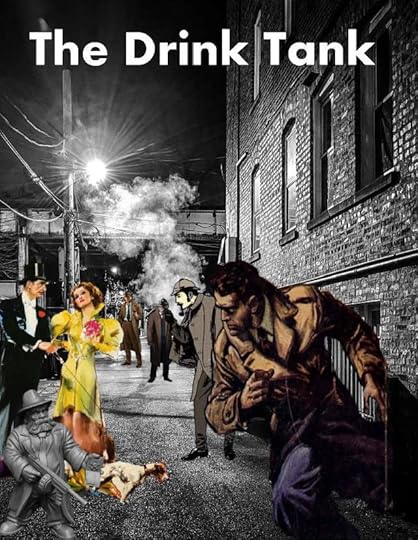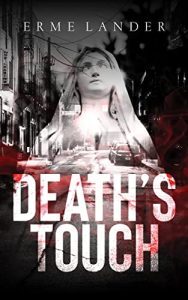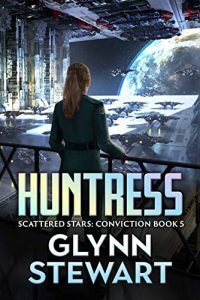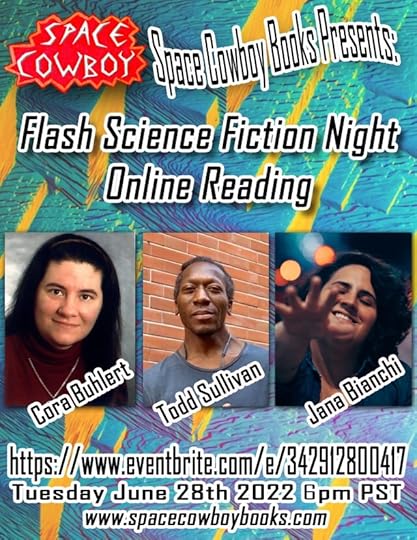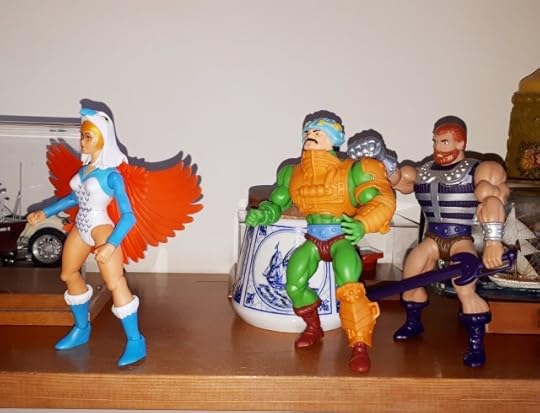Cora Buhlert's Blog, page 24
June 7, 2022
A Trio of Links: Vintage Crime Fiction, 1960s Protests and New Sword and Sorcery
The next Obi-Wan Kenobi and Star Trek reviews are coming, but first of all, here are some links to new work by me that may be found elsewhere:
To begin with, issue 439 of the fanzine The Drink Tank has just come out. The theme of this issue is crime fiction before 1950 and I have an article in it about Harald Harst, a forgotten Weimar Republic era pulp detective. You can also read articles by Christopher J. Garcia, Julian West and Ian Nicholas about topics as varied as Sherlock Holmes, J.G. Reeder or the Moon Man. There is a noir title generator as well.
So what are you waiting for? Download the issue here and start reading.
Yesterday, I was also over at Galactic Journey again with an article about the protests against the visit of the Shah of Iran to West Berlin and the shooting of Benno Ohnesorg in 1967. This was the moment where the peace and love sixties turned violent in (West) Germany and would have reverberations into the 1970s and beyond. It’s also a truly horrifying story, even more horrifying than I knew.
Content warning for photos and descriptions of police violence as well as a photo of a body, because you can’t write about the murder Benno Ohnesorg without the iconic photo of him dying in a West Berlin backyard.
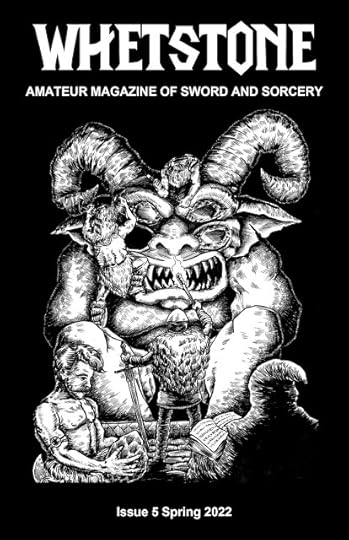 Finally, I also have a story out in issue 5 of Whetstone Amateur Magazine of Sword and Sorcery. It’s called “Village of the Unavenged Dead” and is a dark story about a cruel emperor, a vengeful necromancer and a spooky village.
Finally, I also have a story out in issue 5 of Whetstone Amateur Magazine of Sword and Sorcery. It’s called “Village of the Unavenged Dead” and is a dark story about a cruel emperor, a vengeful necromancer and a spooky village.
You’ll also find new sword and sorcery stories by G.T. Wilcox, Michael Burke, George Jacobs, Dariel Quiogue, T.A. Markitan, Robert O’Leary, Charles Dooley, Jason M. Waltz, Gregory D. Mele, H.R. Laurence, Anthony Perconti, Chuck Clark, Nathaniel Webb, Patrick Groleau, J. Thomas Howard, B. Harlan Crawford, Rev. Joe Kelly, Rett Weissenfels and Scott Oden and an evocative cover by Jake Kelly in this issue. If you’re interested in what the sword and sorcery genre looks like today, you could do worse than check out Whetstone. Best of all, it’s 100% free.
So what are you waiting for? Download issue 5 of Whetstone right here.
June 5, 2022
First Monday Free Fiction: The Beast from the Sea of Blood
 Welcome to the June 2022 edition of First Monday Free Fiction.
Welcome to the June 2022 edition of First Monday Free Fiction.
To recap, inspired by Kristine Kathryn Rusch who posts a free short story every week on her blog, I’ll post a free story on the first Monday of every month. At the end of the month, I’ll take the story down and post another.
June is the first month of summer, so here is The Beast from the Sea of Blood, a summery sword and sorcery story of a trip to the seaside, a crab boil on the beach… and a monster.
So accompany Thurvok, Meldom, Sharenna and Lysha as they face…
The Beast from the Sea of BloodFrom the ocean called the Sea of Blood for its red waters the colour of freshly shed blood rose a small rocky island. Nothing and no one lived here except for a colony of noisy seagulls and some crabs, which scuttled across a narrow strip of sandy beach. This was the Desolate Isle, a place avoided by sailors far and wide, because it was believed to be cursed. At least, that’s what old Danvalk said. But then Danvalk would believe his own bed was cursed, should he happen to fall out of it in a drunken stupor.
Thurvok the sellsword, on the other hand, did not believe in curses. But nonetheless, the red waves, so very much like the fresh blood sprouting from an enemy’s cut throat, unnerved him. As a son of the Eastern steppes, he did not much care for the sea in general. Any body of water larger than a well, a puddle or bathing pond tended to make him nervous. But the Sea of Blood with its eerie gory colouring made him even more nervous. Water should simply not be that colour and only the cannibals of Grokh bathed in fresh blood.
Nonetheless, he was stuck here for the time being. For the Mermaid’s Scorn, a small fishing sloop that Thurvok and his friends had purchased from the one-legged sailor Danvalk, sole survivor of an ill-fated expedition to the lost city of Nhom’zonac, had run aground on the sands just off the Desolate Isle. Until the tide rolled in, she would not sail again. At least, that’s what Sharenna had said and she prided herself in her knowledge of the sea. Even though she had run the Mermaid’s Scorn aground, come to think of it.
Worse, the quest that had brought them here, a great pirate treasure supposedly hidden among the seagull nests, had proven to be a bust. Thurvok’s friend and companion Meldom — thief, cutpurse and occasional assassin — had gotten the story of the treasure from an old acquaintance, who’d claimed that he’d been right there, when it was hidden.
“Well, if the treasure really is so great, why doesn’t he get it himself then?” Thurvok had asked.
Meldom had no answer to that, probably because there was none.
Not that it mattered much. For as usual, Thurvok’s objections had been overridden. For Meldom had never heard a rumour of a treasure he did not want to go chasing after. His lover Lysha inevitably sided with him and besides, she was forever concerned about replenishing their dwindling funds. And the sorceress Sharenna, who would normally have been the voice of reason, liked feeling the sea wind in her hair a little too much. And so Thurvok was outvoted and the quartet set sail for the Desolate Isle. Only old Danvalk, whom the foursome occasionally took along on their quests to take advantage of his sailing skills, flat out refused to come.
“I’m not setting a foot, let alone two, on the Desolate Isle,” Danvalk had insisted, “That place is cursed. Cursed, I’m telling you, and beset by monsters and evil powers.”
Of course, Danvalk only had one foot left — as Meldom was about to point out, when a jab from Lysha silenced him. Nonetheless, the old sailor had a point. For there was something very off about the Sea of Blood and the lone rocky island that rose from its waters.
As soon as the quartet reached the blood-red waters, things started to go wrong. The wind became erratic, alternating between eerie calm and violent gusts. And then, when they reached the Desolate Isle, the Mermaid’s Scorn had run aground. Meldom and Sharenna were still arguing about whose fault that was.
But whoever was to blame, they were all stuck here until the tide rolled in, which should happen in approximately eight hours. And so Thurvok and Meldom had busied themselves scaling the slippery rocks to look for the legendary pirate treasure. They found lots of seagull nests and even more seagull shit. What they did not find, however, was even a hint of any treasure.
“All this bother and nothing to show for it,” Thurvok grunted as he and Meldom sat side by side on top of the highest rocks looking out across the tiny island and the bloody sea roiling all around as far as the eye could see.
“Maybe the seagulls ate the treasure,” Meldom mused, “After all, they seem to eat everything else.”
“And shit it out again,” Thurvok added, “No, if there was a treasure here buried in a pile of bird shit, we would have found it.” He sighed. “This whole expedition has been a waste of time.”
“Would you rather sit in The Rusty Nail in Neamene and drink yourself into a stupor?” Meldom countered.
“As a matter of fact, yes.”
Meldom shook his head. “Some adventurer you are.”
“Better a happy, well fed and drunk adventurer, then hungry, thirsty and shipwrecked.”
Meldom rolled his eyes. “Oh please, you make it sound as if we’ll be marooned here forever. It’s only eight hours…” He looked up at the sun, which had sunk further towards the west, and mentally calculated. “…more like five now. And we do have provisions, so it’s not as if we’ll die of hunger or thirst.”
“Yeah, stale bread and water,” Thurvok grunted, “As if we were prisoners languishing in a dungeon.”
“I wanted to take along some salted herrings for variety,” Meldom said, “But you said you’d rather die than eat another salted herring.”
“It’s not natural for a man to eat so much fish,” Thurvok said.
“That’s just because you’re from the Eastern steppes where fish are as rare as ice beasts, dragons and pots of gold. In the coastal cities, it’s perfectly normal to enjoy the bounty of the sea.”
Even an encounter with a dragon would be preferable to being marooned on this forsaken rock in a Sea of Blood, Thurvok thought, though he did not say so out loud.
Meldom, meanwhile, spotted an ivory gleam among the mounts of bird shit. He rolled up the sleeves of his shirt — black, like the rest of his attire — wrinkled his nose and reached into the pile of shit.
He held the object aloft. “Look at what I found.”
Thurvok looked and shrank back at once with such force that he almost toppled from the rock down to the beach below.
“By the crown of Kresgumm…” he exclaimed.
For the object in Meldom’s hand was not a jewel or a gold doubloon, but a skull. A grinning skull with bird shit sticking between its teeth and dripping out of its eye sockets.
“What’s your problem?” Meldom wanted to know, “This is good news. It means that someone has been here before.”
“Yes, and look what happened to him.” Thurvok scratched his chin in confusion, because he had no real way of knowing what gender the owner of the skull had been. “Her? Them?”
“It probably belonged to one of the pirates who buried the treasure,” Meldom mused.
“Or to another treasure hunter. Or just a hapless shipwrecked sailor.”
“Maybe…” Meldom waved the skull about to shoo away one of the ever-present seagulls. “…a bird ate him.”
“Whatever ate that poor soul…” Thurvok said darkly, “…was a lot bigger than a bird.”
He did his best to ignore the skull in Meldom’s hand and how it was staring at him with its hollow, bird shit dripping eyes.
So instead, he looked down at the beach, where Sharenna and Lysha were skipping across the sand and scrambling between the rocks by the sea. Occasionally, they bent down to pick up something from among the rocks and put it into bucket.
“What are the girls doing down there?” Thurvok wondered.
Meldom shrugged. “Gathering firewood maybe.”
“With a bucket?”
“Why not?”
As if to prove him right, Lysha walked past at just this moment with an armful of dry driftwood, which she began to build into a campfire. Sharenna followed, lugging the bucket.
“Come on down,” she called up at them, “Lysha and I have gathered crabs and mussels for a seafood boil.”
Thurvok wasn’t entirely sure what a seafood boil was, though crabs and mussels didn’t sound particularly appetising. And anyway, what was wrong with plain old meat? Though he figured that even crabs and mussels were better than stale bread and plain water.
Though he was lithely built, Meldom was perpetually hungry. And so the promise of food — even food as unenticing as boiled crabs and mussels — made him to stuff the skull into his bag and begin to scramble down the rock.
With a grunt, Thurvok followed. Though in the end, Thurvok reached the beach before Meldom, who’d been shat upon by a seagull halfway down.
On the beach, Lysha had gotten a good fire going, while Sharenna was bent over the bucket, adding some herbs and oil from her bag.
“You’re not trying to magick us, are you?”
Sharenna rolled her eyes. “Of course not. Herbs and oil are good for both magic and cooking. The only thing that differs is the recipe.”
Thurvok peered into the bucket. A crab peered back at him with black beady eyes and menacingly clicked its pincers.
“Crap, those things are still alive.”
“Of course,” Sharenna replied and took the bucket away to fill it up with water, the eerie blood red water of the sea, “If they were dead, we couldn’t eat them, because they’d have gone off already.”
“I’m not eating live crabs,” Thurvok grunted.
“Don’t worry.” Sharenna hung the bucket with the scrambling, clawing, living crabs over the fire. “By the time dinner’s ready, they won’t be. Even crabs can’t survive boiling water.”
At this moment, Meldom appeared, cursing and brushing at a stain of white-grey seagull shit, which now adorned his jerkin, black like the rest of his garb.
“I’ll never get this out of the fabric again,” he lamented and shook his fist at the seagulls circling overhead.
“Just let it dry and brush it off,” Sharenna said.
“That’ll still leave a stain,” Meldom replied.
“Yes, but you can wash it out with saltwater and vinegar,” Lysha said. When Meldom shot her a curious look, she added, “Oh please, I’m the daughter of a silk merchant. I know a thing or two about removing stains from fabric.”
***
The wind had picked up again and was blowing in cold from the sea, so cold that the four adventurers huddled around the campfire, which was blazing away merrily. The bucket had been hung over the fire and occasionally, Meldom or Sharenna reached out with a stick to shove a crab trying to escape the boiling inferno back into the pot.
Thurvok did not touch the bucket or the crabs. Those scuttling, skittering, clicking things with their beady black eyes freaked him out. There was something unnatural about them.
“So did you find anything?” Lysha wanted to know.
“No treasure, unfortunately,” Meldom said, though he seemed remarkably unbothered by the fact that this whole quest had been for naught. “But we found this.”
He opened his bag and pulled out the skull.
Lysha emitted a little squeak, much to Meldom’s amusement. Sharenna frowned.
“Where did you find that?”
“Up yonder among the seagull nests,” Thurvok replied.
“And the seagull shit,” Meldom added.
Sharenna still frowned. “Could you give that to me?”
“What do you want with that?” Thurvok wanted to know, “It’s all dirty and full of bird shit.”
Meldom’s grey eyes went wide, while his already pale complexion turned a shade paler. “You’re not going to reanimate it, are you?
“Why not?” Sharenna countered, “If there really is a treasure hidden here, the skull might know where it is.”
As a sorceress, Sharenna occasionally engaged in a spot of necromancy, though only in emergencies. And unpleasant as being stuck on an island in the middle of a blood red sea with not a single copper penny to show for it was, Thurvok was not entirely sure if it constituted an emergency.
“I thought you needed whole bodies to reanimate,” he pointed out.
“Oh, it works just as well with parts, though normally there isn’t much of a point to reanimating a severed limb or a headless body. After all, it’s not as if they can do much or tell you anything. A skull, on the other hand…”
“Try it!” Meldom all but shoved the skull at her.
“All right.” Sharenna accepted the skull, wrinkling her nose at the bird shit that was still clinging to the bone. She held the skull between her hands and her expression grew blank and distant, as she called up her magic.
Sharenna closed her eyes. Abruptly, the skull’s jaw dropped, as its mouth opened.
“Beware,” the skull said, its voice grating and hollow, like something from the depths of the underworld, “Beware the Beast from the Sea of Blood. Or it will take you, as it took me. Snapped me in half and left me lying on the beach, my bones to be picked clean by the gulls.”
The skull’s mouth closed. At the same instant, Sharenna opened her eyes and dropped the skull as if it were made of red hot iron. The skull rolled into the campfire and lay there, as the flames ignited the bird shit and licked out of the hollow eye socket.
Sharenna seemed troubled, so Thurvok quickly put his arm around her, pulling her close.
“Are you all right?”
Sharenna nodded weakly. “I just need a moment.”
Meldom reached out with a stick to pull the skull out of the fire and cursed, as the stick caught fire as well.
“Now that was ominous,” he announced, “And utterly unhelpful. Nothing about a treasure, just some blather about how the seagulls picked clean his — or her — bones. As if it wasn’t bloody obvious that that was what happened.”
“Don’t forget the beast,” Thurvok pointed out, “It also talked of a beast.”
“Yes, the beast from the sea of blood. And what exactly is that supposed to mean?”
“I for one am not keen to find out,” Thurvok said.
“I just wonder how that skull could talk at all,” Lysha wondered, “After all, it neither has a tongue nor vocal cords.” She cast a doubtful glance at the skull and the flames that enveloped it. “At least, I think it doesn’t.”
Meldom scowled. “No matter how the skull managed to talk, I still think he — she — could have been more precise. I mean, is this beast a sea serpent, a mermaid, an oversized fish, a creature like the monstrous guardian of the lost city of… well, you know what I mean?”
“Does it matter?” Thurvok countered, “It’s a beast and it killed this poor soul. Does it really matter what manner of creature it is?”
“As matter of fact, yes. If we knew what it is, we would have some idea how to fight it? But a beast could be anything, even those blasted seagulls. After all, their shit truly is beastly.” Meldom futilely began to rub at the stain on his jerkin again.
“It’s not a seagull,” Sharenna said suddenly, “But something much bigger and much more dangerous. I couldn’t see it, because he couldn’t, but I felt his fear and his desperation, as he tried to climb the rocks to save himself. But he wasn’t fast enough and so the best got him.”
“How do you know all that?” Thurvok asked.
The flickering firelight illuminated Sharenna’s face and suddenly she looked very witchy indeed. “Sometimes…” she began, “…when I reanimate a body, I get an impression of their final moments. This is what I got from him. And yes, it was a man. A sailor. I could see that very clearly.”
“Did you get anything about a treasure?” Meldom asked, single-minded as always.
Sharenna shook her head. “No, only his final moments. And they didn’t involve a treasure, just fear, terror and an unseen monster.”
“So what do we do now?” Lysha wanted to know, “About the monster, I mean?”
“I don’t think there is much we can do,” Sharenna replied, “Except wait for the tide to roll in, so we can take the Mermaid’s Scorn and get out of here. But until then…”
She peered into bucket and stirred it with a stick, pointedly ignoring the flaming skull at her feet.
“…dinner is ready.”
***
Sharenna emptied the bucket and all four of them cracked open the crabs and mussels to get at the soft flesh within. And even Thurvok, who was deeply suspicious of the sea and anything connected with it had to admit that the food was good.
Meldom waded over to the Mermaid’s Scorn and brought back a jug of rum, which they shared around the fire, while the sun slowly sank towards the western horizon.
“How much longer?” Thurvok asked, keeping a wary eye on his surroundings, just in case this beast the skull had mentioned decided to put in an appearance after all.
“Not long now,” Meldom promised, “The water is already coming back. Another hour or so and the Mermaid’s Scorn will sail again.”
Thurvok looked at the sun, which was already very close to the horizon, painting the Sea of Blood even redder.
“In an hour it will be almost dark,” he said, “Can we even make it back to Neamene in the dark?”
“Of course, we can,” Sharenna replied, “After all, the fisherman go out to sea by night. And if they can navigate in the dark, then so can we.”
Thurvok was about the point out that Sharenna’s and Meldom’s navigation skills were what had caused the Mermaid’s Scorn to run aground in the first place, but then he thought the better of it. He knew a lost argument, when he saw one.
And besides, his stomach was full, the rum was warming his chilly limbs and even his worries about the skull’s ominous pronouncements were slowly fading. In fact, Thurvok felt as comfortable as he had ever since they set out for the Desolate Isle. But as always, when life was going well, it could not last.
Meldom heard it first, a clicking, scuttling sound blowing in from the sea with the wind.
“Please not a storm, please not a storm,” he muttered to himself and turned towards the sound. “What in the name of the Seven Gods of Grayvault,” he exclaimed.
For from the Sea of Blood, halfway to the horizon and further out than the Mermaid’s Scorn, rose a rock where there hadn’t been one before.
“Maybe the tide uncovered it,” Thurvok suggested.
“When it recedes maybe,” Meldom countered. His hand reached for the sheathed dagger at his waist, “But the tide is rising.”
And then the rock ended all speculations, when it began to move, move inexorably towards the shore.
They all jumped to their feet, the fire and the rum forgotten. Thurvok drew his word. Meldom pushed Lysha behind him and drew his dagger. Sharenna stood between them, outwardly calm, but the slight glow around her hands showed that she was calling up her magic.
The thing grew ever bigger as it approached the island. By now, Thurvok could make out details. Eight scuttling legs. Two black beady eyes the size of a baby’s head. And two clicking pincers big enough to snap a man clean in half.
“This would be the beast then,” Sharenna said.
“Uhm, folks, I think it’s angry that we ate its brethren,” Lysha whispered and reached for the slingshot she used for defence.
Meldom sheathed his dagger, for it was clearly no good against a creature of this size, and drew his own slingshot.
And still the giant crab scuttled towards the beach, pincers clicking menacingly. Meldom and Lysha fired their slingshots and pelted it with pebbles and seashells, which did not even slow the thing down.
Thurvok rushed to meet the creature in the lapping water, his mighty sword raised high above his head. He swung his blade in a mighty blow that would have taken a man’s head clean off. But the blade glanced harmlessly off the creature’s shell, while the backlash knocked Thurvok off his feet and into the wet sand.
The beast was almost upon him now, but Thurvok managed to scramble to his feet just in time. He changed tactics and stabbed at the thing, again and again, hoping to find some weak spot. But the point of his sword could not pierce the monster’s sturdy shell and so he only succeeded in annoying the creature. The crab swung one of its pincers towards Thurvok, snapping madly, and only a quick roll to the side saved him from decapitation.
He got to his feet again and swung his sword, this time aiming low at the legs. But once more, it was to no avail. There was no way to stop this creature, no way to even slow it down. All four of them would end like the poor fellow whose skull Meldom had found among the rocks, snapped in half, their bones picked clean by seagulls.
“Get back,” Sharenna cried out, “Its armour is too strong. Your blade can’t hurt it.” She called up a fireball in her hands. “But my magic can.”
Once Thurvok had rolled clear, Sharenna hurled her fireball at the critter. It missed the massive armoured body and landed in the water at its feet instead, exploding in a hiss of steam.
“You missed,” Thurvok called out.
“No, I didn’t.” Sharenna hurled another fireball at the thing’s feet. It hit the water with a hiss and bathed the thing in steam. “I’m boiling the crab.”
After the third fireball, the crab screeched in pain, while the steam and the hot water slowly turned its shell a bright fiery red. But it took another five fireballs, until the thing finally collapsed into the shallow water, quite dead. Waves crashed onto the sand, drenching their shoes and the hems of their clothes.
Sharenna swayed and would have fallen, if Thurvok had not caught her by the waist. Using her magic always took a lot out of her and taking down the giant crab had required some mighty magic.
“Uhm, guys…” Lysha pointed at the horizon, where two more rocks, which had not been there before, had appeared, while the wind blew a scuttling, clicking sound towards the beach, a sound that was getting steadily louder.
“I’d suggest we’d better get back to the ship and away from here fast,” Meldom said, “Before more of those things show up.”
“Can the ship even sail again?” Thurvok wanted to know.
“It’ll have to, unless we want to be crab fodder.”
“And what if we can’t get free?” Lysha asked.
“Then Thurvok will have to get out and push.”
So they all raced for the Mermaid’s Scorn. Meldom and Lysha dashed ahead to unfurl the sails, though Meldom thought to grab the jug of rum first. Thurvok picked up Sharenna, who was still too weak to run, and carried her on board. He set her down against the stern railing and gripped the tiller, following Sharenna’s directions. For unlike Thurvok, Sharenna knew a little about the sea and sailing.
As the Mermaid’s Scorn sped away from the Desolate Isle, Thurvok looked back and saw two giant crabs launching themselves at their fallen comrade, while more of creatures rose from the sea. Seagulls circled overhead.
It was only when they were well away from the Desolate Isle and its monstrous inhabitants and had reached the area where the blood-red sea turned into regular blue-green again — or would, if night hadn’t fallen in the meantime, turning the water to ink — that they dared to relax.
Thurvok fastened the tiller with a rope and Meldom evenly divided the last of the rum between four cups.
“Well, we did not find the treasure, but that was certainly an adventure,” he said, “And it will make a grand tale to tell at The Rusty Nail or any other harbour bar in Neamene.”
“So more gullible folks will come here in search of treasure and night have their heads snapped off,” Thurvok grumbled.
“Well, that’s their choice, isn’t it? After all, it’s not as if we’re going to pretend that we found the treasure.”
“Maybe we should,” Lysha pointed out, “To discourage other adventures and make sure they won’t get eaten by the monster crabs.”
Meldom laughed. “That won’t work. Cause don’t you know that rumours of treasures found always draw more treasure seekers.”
“Well, you should know,” Thurvok said, “After all, there was never a rumour about a treasure that you did not follow up on. Even though all it ever got us was vengeful corpses, crazed cultists, tentacled monsters and now giant crabs.”
“And bird shit,” Meldom said, still rubbing at the stain on his jerkin, “Don’t forget the bird shit.”
“Oh, stop complaining,” Sharenna, who was largely recovered by now, said, “At least be grateful that it was a regular sized seagull and not a monster-sized one.”
Thurvok lifted his cup. “I’ll drink to that.”
***
That’s it for this month’s edition of First Monday Free Fiction. Check back next month, when a new free story will be posted.
June 1, 2022
Down and Out in Tatooine and Alderaan: Some Thoughts on Obi-Wan Kenobi Parts I and II
Since last weekend was a long holiday weekend in the US, Disney Plus in its infinite wisdom has decided to give us the first two episodes of Obi-Wan Kenobi in one go and then the next episode dropped today. Though the first episode begins with what is basically a recap of the prequel trilogy in five minutes.
But before we get started, fellow Hugo finalist Camestros Felapton is currently doing profiles of all the 2022 Best Fan Writer finalists and today it was my turn. Also check out Cam’s profiles of Chris M. Barkley, Bitter Karella and Alex Brown with Jason Sanford and Paul Weimer still to come.
But now, let’s get back to Obi-Wan Kenobi.
Warning: Spoilers after the cut!
When the episode proper opens we get another flashback to Order 66 and the slaughter at the Jedi Temple. A female Jedi teacher gives her life in order to protect five padawans, who manage to escape. I’ve heard some complaints online that because this episode streamed so soon after the devastating Uvalde school shooting, it should have come with a warning label like season 4 of Stranger Things. Initially, I was initially a bit dismissive of this, because surely everybody who sits down to watch a Star Wars TV show about Obi-Wan knows about Order 66 and the slaughter of the padawans at the Jedi Temple. However, at the time I did not know that this scene is literally the first thing you see (except for the title and the lengthy flashback), when you sit down to watch the episode, so you have no foreshadowing or warning at all. So yes, Disney should really have added a warning label.
Ten years later, one of the escaped padawans, a young man named Nari, has made his way to Tatooine, because everybody in Star Wars eventually ends up on Tatooine. And because everybody eventually goes to Tatooine, Nari has three Imperial Inquisitors – basically lightsabre wielding and Force sensitive Jedi hunters who were introduced in the Star Wars Rebels cartoon – on his tail.
Those Inquisitors, the Grand Inquisitor (a pasty-faced white guy), Fifth Brother (a pasty-faced Asian guy) and Third Sister (a black woman with awesome cornrows), come to Anchorhead to harass a barkeeper. The reasoning behind this is that – as one of the Inquisitors puts it – “the Jedi hunt themselves”. Because Jedi, being essentially noble, compassionate and good-hearted, cannot help themselves helping people in need. But whenever someone displaying Force abilities or brandishing a lightsabre at evildoers appears somewhere, there are bound to be rumours. The Inquisitors follow up those rumours and one of those rumours led them to Tatooine, specifically to this bar in Anchorhead. Because it turns out that the barkeeper had a spot of bother with some criminal lowlives and was saved by Nari, who had to use his Jedi skills to help him.
There’s something incredibly depressing about compassion being twisted into a fatal weakness here. And considering that the Star Wars universe is a terrible place, always has been and always will be, this show does a good job of portraying the generally awful Star Wars universe as just a bit more awful then usual
We get all this in a speech from the Grand Inquisitor, until Third Sister, who’s the impulsive type, hurls a knife straight at the barkeeper, forcing Nari to use the Force and reveal himself. Nari does manage to escape the Inquisitors, for now. Third Sister, whose real name is Reva, gets dressed down by the Grand Inquisitor. We also learn that Third Sister is really, really obsessed with hunting down Obi-Wan Kenobi.
Which brings us to the other Jedi on Tatooine who has been living there under the radar for ten years at this point. We first see Obi-Wan, who now goes by Ben, working at some kind of alien meat processing plant in the Tatooine desert, where that planet’s abundant mega-fauna is transformed into food for sale. Meat processing plants on Tatooine are as awful as on Earth, if not worse, and so the owners are ruthlessly exploiting and underpaying the workers. We see the foreman harassing a worker, while Obi-Wan stands by and does nothing. Unlike Nari, he will not give himself away, betrayed by his own compassion. Or maybe he is just too numb to care.
We follow Obi-Wan through his day, as he returns to his mount/pet/only friend in the universe, a camel-like eopie, played by a camel named Silas, whom Ewan McGregor almost wound up adopting. Obi-Wan even steals a slice of the alien meat he’s supposed to process for his one true friend in the universe. Then he returns to the cave where he has made his home. The only other contact Obi-Wan has is with a Jawa, who steals parts from his vaporator to sell them back to him (“You could at least clean them first,” Obi-Wan tells him) and who also procures other items for Obi-Wan such as a spaceship toy (which looks just like a beat-up vintage Kenner Star Wars toy). The Jawa also tells Obi-Wan that there is another Jedi on Tatooine, which the Jawa knows, because he stole his belt. Obi-Wan does not react to the mention of a fellow Jedi.
Next, we see Obi-Wan and his faithful eopie friend making their way to some rocks in the desert, which just happen to overlook the farm of Owen and Beru Lars. Obi-Wan tends to hide among those rocks and spy on the Lars family and particularly their young nephew Luke Skywalker, who even at the age of ten tends to sneak away from his duty to pretend to be podracing. After the Lars family has gone to sleep, Obi-Wan leaves the spaceship toy behind as a gift for Luke. It seems to be the same spaceship toy that young adult Luke has in A New Hope, by the way.
If Obi-Wan’s life sounds depressing, that’s because it is. He’s less living than existing and he seems to have a massive case of PTSD complete with nightmares, which exactly surprising considering what Obi-Wan has been through. Obi-Wan also keeps calling for the Force ghost of his old master Qui-Gon, but gets no reply (was Liam Neeson otherwise engaged?). Though only middle-aged, Obi-Wan is a sad old man who lives in a cave and stalks a happy family, watching from afar the one thing he can never have.
Jedi don’t tend to live long in the Star Wars universe – most of them die in battle well before their time or they turn to the Dark Side. As for those who survive, their ultimate fate seems to be ending up as a sad old hermit living in a cave. This is what happened to Obi-Wan, to Yoda and to Luke. I honestly wonder why do many people still view the Jedi as aspirational, when the actual Star Wars movies and TV shows have shown time and again that the Jedi inevitably fail and that the whole concept just doesn’t work.
Ewan McGregor is excellent at portraying Obi-Wan has a broken man aged before his time, by the way. Of course, we always knew that Ewan McGregor was an excellent actor, but he really knocks it out of the park here, as Andy Welch points out in his review at The Guardian.
Obi-Wan’s secret gift to Luke is not appreciated, as he finds out when Owen Lars (played once again by Joel Edgerton who played him in the prequels) confronts him in the streets of Anchorhead on the very next day to return the toy and tell Obi-Wan in no uncertain terms to keep the hell away from his family. Owen goes full Papa Bear on Obi-Wan here and tells him that Obi-Wan doesn’t really care about Luke at all, he only cares if Luke is manifesting Force abilities. Obi-Wan tries to tell Owen that Luke needs to know that there is more to life than Owen’s farm, that there is a big galaxy out there and also that Luke needs to be trained. “Like you trained his father?” Owen counters and you can see on Obi-Wan’s face that this blow really hit the point.
IMO, Owen and Beru Lars (and Bail and Breha Organa, for that matter, but more about them later) have never gotten the credit they deserve for raising Luke (and Leia) to grow up into good people who don’t succumb to the Dark Side of the Force. It’s also telling that in no version of what happens after Return of the Jedi do Luke or Leia ever name any of their kids after the people who actually raised them, while Obi-Wan/Ben gets a kid named after him twice (though the less said about Ben Solo the better) and in the Expanded Universe, Han and Leia even name one of their kids Anakin. Ignoring the people who raised Luke and Leia to be good people has always struck me as an odd oversight. Furthermore, Star Wars fandom seems to be particularly harsh on Owen Lars for trying to keep Luke on the farm and stymying his ambitions to leave Tatooine and go to the Academy.
However, try to see things from Owen’s point of view. As far as he knows, Anakin was a normal kid, until the Jedi came to Tatooine to take him away. The next time he meets Anakin (actually, the first time Owen meets him, since they are stepbrothers), he’s a troubled young Jedi with his girlfriend in tow who does try to rescue his mother and slaughters a whole tribe of Tusken Raiders in the process. Then the next time Owen hears about Anakin, Obi-Wan tells him that Anakin is dead and Padme is dead, too, and would Owen and Beru please raise Anakin’s orphaned kid. I’m not sure how much Owen ever knew about what exactly happened to Anakin and Padme? He certainly doesn’t know that Anakin became Darth Vader, but did he know that Anakin went bad and slaughtered a whole lot of people, including kids. Does he know that a large part of the reason why Padme died giving birth is because Anakin force-choked his pregnant wife? Or does he believe that Anakin fell in battle? At any rate, as far as Owen is concerned the trouble started when the Jedi came to take Anakin away. He’s not wrong either, because the Jedi and their complete and utter incompetence are to blame for Anakin ultimately falling to the Dark Side. And Owen is not going to let that happen to Luke, even as it increasingly becomes clear that Luke is his parents’ kid and not made for the farming life. Plus, Luke grows up at a time when not only full Jedi, but Force-sensitive kids are being hunted. So in short, Owen is trying to protect his (adopted) son like any father would. And make no mistake, Owen and Beru were good parents to Luke.
One night, Obi-Wan realises that someone is following him. It turns out to be Nari, who spotted Obi-Wan in Anchorhead and followed him, hoping for help in rebuilding the Jedi Order and liberating the galaxy or maybe just escaping the Inquisitors. Obi-Wan initially does his “I don’t know what you’re talking about. You must have me confused with someone else. My name is Ben” routine, but when Nari won’t go away and even shows him his lightsabre, Obi-Wan tells him to bury the lightsabre in the desert, walk away and live a normal life. “But what about the fight?” Nari asks. “It’s over,” Obi-Wan replies, “We lost.”
However, the Inquisitors, particularly Third Sister, are no more willing to give up than Nari is. And so they are harassing the people of Anchorhead again the following day, demanding that they give up the Jedi or face the consequences. Obi-Wan just manages to duck into an entrance before he is spotted and recognised. A woman tells the Inquisitors that the Empire doesn’t even have any jurisdiction in the Outer Rim and promptly gets her hand chopped off for her troubles. Third Sister then zeroes in on Owen and asks him if he has seen any Jedi. Owen replies that he hasn’t seen any Jedi and that he has no love for the Jedi, but thinks they are vermin to be exterminated. Third Sister, however, is not convinced and threatens to kill Owen and his family, if the people of Anchorhead don’t give up the Jedi. She even puts her lightsabre to Owen’s throat, before her fellow Inquisitors stop her. Owen barely flinches, when he has a lightsabre at his throat, which shows that in his own way, Owen is a badarse.
Once the Inquisitors have left to harass someone else, Obi-Wan comes out of hiding and thanks Owen. “I didn’t do it for you”, Owen replies. It’s the truth, too, because Owen does not care what happens to Obi-Wan. However, he clearly fears for Luke, especially since Luke very likely already is showing Force abilities at this point. After all, we know that he inherited his father’s piloting skills and quick reflexes, which are one way Force abilities manifest itself. And Owen probably recognises the signs from his experience with Shmi and Anakin.
The Inquisitors eventually get their man and the next time Obi-Wan is in town, he sees Nari or rather what’s left of him strung up for all the town to see. Obi-Wan clearly knows that he could have helped Nari, but chose not to.
Meanwhile on Alderaan, a ten-year-old Princess Leia is enjoying a considerably more privileged life than her twin brother. Though little Leia is not happy with her princessly duties. She does not want to be dressed up, she does not want to attend state functions and she does not want to wave at people from the isolation of a groundcar. She doesn’t want to be a Senator either, because that’s boring. However, little Leia hasn’t yet fully figured out what she wants to do with her life. However, for now what she wants is run off into the woods outside the palace with her little droid companion. She wants to climb trees and watch the spaceships coming in and taking off, cause little Leia really likes spaceships.
When we first see little Leia – or rather what we think is little Leia – she is being dressed by a bunch of servants in order to meet her aunt, uncle and cousins. However, when her mother Breha (New Zealand actress Simone Kessell) comes to pick her up she finds another little girl wearing her daughter’s ceremonial outfit. Clearly, Leia has inherited the tendency to switch places with handmaidens and servants from her mother Padme.
Eventually, Breha and some guards find little Leia in a tree and drag her to meet her aunt, uncle and cousin. At the reception that follows, the uncle reveals himself as an Imperial profiteer (“Finally, we can make some money”) who gets rich of slave labour. Leia trades some barbs with her older cousin who first insults her for thanking a droid (“It’s good manners”, Leia says, and yes, that droid not only looks like C-3PO, but actually is him, played by Anthony Daniels even) and then tells her she’s not a real Organa, whereupon Leia tells the cousin that he wants nothing more than be like his father, but that he never will be and that he’ll always be a failure. In general, little Leia shows some remarkable psychological insight into people she meets, which I strongly suspect are her Force abilities manifesting themselves. After all, we know that Leia is telepathic.
Vivien Lyra Blair, the young actress who play little Leia, is amazing in the role and truly channels Carrie Fisher, as both Tor.com reviewer Emmet Asher-Perrin, io9 reviewer Germain Lussier and Ben Sherlock of ScreenRant point out. I have no problems believing that one day, this little girl will grow up to become the Leia we all know and love. When little Leia is uncertain about what she wants out of life, only that waving behind glass isn’t it, you want to hug her and tell her that she’ll find her purpose and that she’ll have an amazing life, that she’ll have lots of friends, a brother and that she’ll get to kiss (and more) the hottest space rogue in the galaxy.
We have never seen more of Alderaan than a brief glimpse at the end of Revenge of the Sith, when Bail Organa brings baby Leia home. It does look uncannily like a California woodland with some futuristic white spires added. On the one hand, I really like seeing more about Leia’s (and Luke’s, though we haven’t seen much of him yet) childhood, since the movies completely skipped over this part of the story. On the other hand, those scenes are also disturbing, because we know what will happen to Alderaan. We know that those forests and futuristic spires as well as all the people we see, including Bail and Breha Organa, will be blasted to smithereens by the Death Star. Just as we watch Owen and Beru Lars knowing that both will be murdered by Imperial Stormtroopers, while trying to protect their adoptive kid.
As soon as she can slip away, little Leia and her droid pal run off for the woods again. But this time, she runs straight into trouble in the form of a sinister and strangely familiar looking fellow who looks as if he stepped right out of a late 1980s cyberpunk influenced science fiction film. As for why the fellow looks familiar, that’s because he’s Flea of the Red Hot Chili Peppers, who also has an acting career going back to the 1980s.
For a ten-year-old, little Leia is quite formidable and leads her would-be kidnappers on a chase through the forest. However, she is also still only ten years old and so she is eventually caught and taken away by the kidnappers on their spaceship. The lead kidnapper tells little Leia that she’ll never see her family again, whereupon Leia stares him down and tells him that yes, she will see them again and that her father will send an army and then her kidnappers will be very sorry. At this moment, you can clearly see the woman who will face down Darth Vader and Grand Moff Tarkin some ten years later in this little girl.
Bail and Breha are understandably frantic, once they realise that little Leia has been kidnapped, especially since there is no ransom demand. And so they contact the one person they know they can trust to get her back, namely Obi-Wan. When his holographic communicator starts beeping, Obi-Wan has to dig through his possessions to find it. He also tells Bail and Breha that he’s not the man they remember, that he can’t help them and besides, he must stay on Tatooine to watch over Luke.
We all know that the original Star Wars movie a.k.a. A New Hope closely followed the “hero’s journey” template according to Joseph Campbell, since George Lucas was never shy talking about it and Campbell was very likely grateful to Lucas, since the Star Wars connection helped to sell a whole lot of copies of The Hero With a Thousand Faces, which had been a fairly obscure folkloristic popular science book before then.
One part of the hero’s journey is the “refusal of the call”, where the hero (or heroine) initially refuses the call to adventure. In A New Hope, this is the moment where Luke tells Obi-Wan that he can’t go with him to Mos Eisley, let alone Alderaan, because he has to be home for dinner. And in A New Hope, the refusal of the call feels organic, though in many other cases, it feels shoehorned in, as if the protagonist only refuses the call, because the hero’s journey requires this step. One example is the 2002 He-Man and the Masters of the Universe cartoon, where Prince Adam, when he is taken to Castle Grayskull on his sixteenth birthday and informed that he is the chosen hero to defend the secrets of Castle Grayskull and all of Eternia, tells the Sorceress that she’s got the wrong person, that he’s not the hero type and why doesn’t she ask Man-at-Arms who’s standing right there and clearly would make a much better hero. On the one hand, it is sweet that Adam immediately thinks Duncan is the one who should be the hero to defend Eternia, but on the other hand, the whole scene also doesn’t fit the characters or any other version of this story, because one thing that all versions of Masters of the Universe have always stressed is that Adam not only is brave and heroic, he also wants to be recognised as a hero in his own right. At any rate, Prince Adam never strikes me as someone who would refuse the call to adventure, but the hero’s journey requires that he does.
Obi-Wan, on the other hand, does not only repeatedly refuse the call to adventure – when the foreman bullies a co-worker, when Nari asks him for help, when Third Sister threatens Owen and the rest of the people of Anchorhead, when Bail and Breha ask him to find Leia – he literally buries his head in the sands of Tatooine so he won’t have to hear the call to adventure. It’s a great subversion of both the hero’s journey and expectations in general, since so far we have only known Obi-Wan as the Jedi who will immediately launch himself into action. This repeated refusal of the call shows how much he has changed and how broken he truly is.
Coincidentally, it also shows how twisted and Empire and its Inquisitors truly are, because they literally use the Jedi’s natural compassion and desire to help those in need against them. Obi-Wan was only able to stay hidden for so long, because he hardened his heart against the plea of anybody in need. And – as it turns out – Third Sister is using both Obi-Wan compassion and his old friendship with Bail Organa against him and orchestrated the kidnapping of little Leia in order to draw Obi-Wan out. Though she clearly has no idea of the much greater prize she has caught, namely the daughter of Darth Vader himself.
The next evening, Obi-Wan find Bail Organa himself (still played by Jimmy Smits who has by now gone from “Hey, that guy from L.A. Law and NYPD Blue plays Leia’s Dad” to “Did you know Bail Organa used to be in L.A. Law and NYPD Blue?”) in his cave, waiting for him. Obi-Wan is not happy to see him and tries his full sticking his head in the sand and refusing the call routine again, but Bail won’t have any of that. And so Obi-Wan digs up his lightsabre as well as Anakin’s from the spot where he buried them in the desert. And yes, even with Jedi powers it’s amazing that he found the box again, considering I managed to lose a treasure chest I buried in my parents’ own garden, which is considerably smaller than the desert of Tatooine. Then he gets on a transport – as a down and out ex-Jedi, he no longer has his own ship – and heads for a planet named Daiyu to rescue Leia.
Daiyu looks amazing, a Blade Runner-esque hive of scum and villainy straight out of a 1980s cyberpunk novel. Even though Blade Runner actually came out a year before Return of the Jedi and cyberpunk started up almost directly after the Star Wars boom, Star Wars itself has never really embraced cyberpunk tropes and aesthetics until fairly recently and a lot of fans were not happy when it did. However, I really like how the various recent Star Wars TV shows not only go back to inspirations of the original Star Wars such as Italian westerns and samurai films, but also to works, styles and trends that came out around the same time and could well have inspired Star Wars, only that we have no record of it. So cyberpunky neon hellscape of Daiyu absolutely fits into Star Wars.
Obi-Wan wanders around the wretched hive of scum and villainy that is Daiyu, asks questions and claims he is looking for his lost daughter. A drug-dealing punk girl (played by Ewan McGregor’s real life daughter Rose McGregor) tells him to give up, that he’ll never find her and then gives him a free sample of her wares, so he can forget his mission. Obi-Wan also has a brief encounter with a decommissioned and homeless clone trooper (played by Temuera Morrison in a cameo that’s both squeeworthy and disturbing for showing that the Empire treats even its most loyal troops like shit) who’s reduced to begging on the streets. And yes, that’s also very obviously a comment on the problem of homeless military veterans in the US, because Star Wars has always been political. Obi-Wan is clearly terrified – Does he know this particularly trooper by any chance? And does the trooper recognise him?
Shortly thereafter, a street kid approaches Obi-Wan and tells him that there is a Jedi on Daiyu who helps people… for a price. Intrigued, Obi-Wan follows the kid – Jedi help would be welcome – and meets Haja Estree, played by Kumail Nanjiani of Eternals fame, who’s also a huge geek in real life. Haja Estree is not a Jedi, but a skilled con artist pretending to be a Jedi via magnets, fake mind control and other tricks. He really does help people and in his introductory he helps a woman and her Force sensitive kid escape Daiyu, though he also fleeces his victims.
Now a con artist pretending to be a Jedi was not even remotely on my list of things I expected to see in a Star Wars series, though it also makes complete sense, because with the Jedi already passing into legend at this point, the existence of a con artist using the legend of the Jedi for his own ends is not unlikely at all. Obi-Wan, however, is appalled and threatens Estree with his blaster – no lightsabre or Jedi powers required for this fraudster – and gets him to tell him where Leia’s kidnappers are.
It turns out that Leia is being held in a drug-processing facility. Obi-Wan sneaks in, pretending to be one of the workers processing and packing the drugs. He breaks open a door and finds what he thinks is Leia, but it’s really just a droid in a cloak tied to a chair. Turns out it’s a trap – cue Admiral Ackbar voice – and Obi-Wan soon finds himself surrounded by Flea of the Red Hot Chili Peppers (apparently, his character is called Vect Nokru) and his thugs who proceed to kick the crap out of him. This is the point where we realise that Obi-Wan truly is not the man nor the warrior he used to be, since his fighting – and as we will see later in the episode, Force skills – have gone rusty. His brain is still sharp, however, and though he throws the vial of Spice the drug-dealing punk girl gave him onto the floor. Obi-Wan holds his breath and replaces his respirator mask, while Vect Nokru and his thugs get a noseful of Spice and are drugged out of their minds for the next hour or so. It is interesting that the Spice we saw in an episode of The Book of Boba Fett was sand-coloured, but this stuff is red. Do drug dealers mix colour into spice or are there differently coloured types of the stuff? And can we maybe find a better name for it, especially considering that “Spice” was cribbed wholesale from Dune?
Obi-Wan finally finds the real Leia and is promptly hit be her with a chair, because Leia has already freed herself with the help of her little droid Lola (who unfortunately was badly damaged in the attempt). Even at the age of ten, Leia is not particularly impressed by people trying to rescue her and let’s Obi-Wan know in no uncertain terms, that she expected an army rather than an old man named Ben. And no, Leia will definitely not pretend to be his daughter, because as far as she is concerned, he looks old enough to be her grandfather.
Little Leia continues to be a handful, because when Obi-Wan ditched the drug-processing worker device and decides to buy some clothes for little Leia, Leia is not at all happy with the dull Yoda-green poncho Obi-Wan selects and would rather have something sparkling and pretty. “We’re trying not to draw attention to ourselves,” an exasperated Obi-Wan explains and buys the boring poncho, though he does relent on sparkly cut off gloves.
Meanwhile, Third Sister has arrived and finds Vect Nokru and his hench people drugged up to their gills. She is not happy that Obi-Wan has escaped again, but at least she knows that he is on Daiyu now. And so she places a huge bounty on his head and sends a message to every bounty hunter and other criminal on Daiyu. And since Daiyu is a cyberpunky criminal hellhole, there are a lot of them.
Worse, Leia chances to see the holo on the wrist communicator of a random lowlife, notes that this is the guy who rescued her, but that his name is not Ben, as he claimed, but Obi-Wan. So Leia – who after all has just been kidnapped and was rescued by a guy she’s never seen before and isn’t sure she can trust – decides that Obi-Wan is no more trustworthy than her kidnappers and may in fact be one of them. Also, he lied about being a Jedi and even at the age of ten, Leia realises that all of the people with the blasters are after Obi-Wan because he is a Jedi and that she’s about to get caught in the crossfire. So she runs off and Obi-Wan now has to chase after Leia, while trying to dodge bounty hunters left, right and centre.
This turns into a thrilling chase across the rooftops of Daiyu, which takes up the bulk of episode 2. Guardian reviewer Stuart Heritage isn’t entirely sure if a series focussing on Obi-Wan between Revenge of the Sith and A New Hope needed to be made at all, but he really enjoyed the action scenes and he is right, too, because the action and fight scenes are very good, especially since they show Obi-Wan very much not in top form and also trying to hide his Jedi skills, lest he be recognised.
This multiple way chase eventually leads to Obi-Wan getting cornered by two bounty hunters on a rooftop, while trying to persuade Leia not to make the jump across the gap to another rooftop, because the gap is too wide for her little legs, while on another rooftop, Third Sister stands in best Batman manner, observes the laser fire and knows she has found her quarry.
Leia, being the stubborn type, tries to make the jump and of course doesn’t make it, but winds up clinging to a wire, so Obi-Wan now has to rescue her from falling to her death by using the Force in what appears to be the first time in ten years or so. And while using the Force to lift up a ten-year-old kid wouldn’t have been a challenge for Obi-Wan in the old days, it clearly is now, since he is visibly straining to hold Leia and gently set her down. Tor.com reviewer Emmet Asher-Perrin calls it Force athritis and that’s exactly what it looks like.
AV-Club reviewer Sam Barsanti points out that Leia meeting Obi-Wan ten years before the events of A New Hope does mess up continuity, since there is no indication that Leia knew who Obi-Wan was, when she sent out the holographic SOS hidden inside R2-D2. However, there is also no indication that she didn’t know who he was either. Also, it never made sense to me that Leia would name her only child after a man she only briefly saw once, as he was being cut down by Darth Vader with a lightsabre. Never mind that only Luke called Obi-Wan Ben, while Leia calls him Obi-Wan and General in her message. However, if Leia actually met Obi-Wan as Ben, it makes a lot more sense that she would name her son after him.
At one point, Obi-Wan tells little Leia that she reminds him of someone. Of course, we all think that he is going to say Anakin, but instead he talks about Padmé, though he does not say her name. When Leia asks about this, Obi-Wan tells her that she was a friend and a leader and that she died a long time ago. Are those the seeds that persuade little Leia that she, too, can be a leader and that being a princess need not mean waving at people from groundcars? Time will tell.
Meanwhile, the street kid which led Obi-Wan to the false Jedi Haja Estree has also seen the Wanted holo and bounty offered and immediately runs to Estree to tell him that they had a really big fish on the hook and let him go. Estree pales, once he realises that he just met an actual bona-fide Jedi, and heads out into the mean streets of Daiyu. He catches up with Obi-Wan just after he has saved little Leia from certain death, tells him that the passenger spaceport has been shut down and is being monitored, but that there is an automated cargo port they can use to escape. Estree also gives Obi-Wan an access key. When Obi-Wan asks Estree why he’s suddenly helping them, Estree replies that he’s trying to make amends, before sending Obi-Wan on his way.
Is Estree honest and is a really just someone trying to make his way in a hostile galaxy anyway he can? It’s possible and Star Wars has its share of criminals and outlaws with a heart of gold, see Han Solo and most of the cast of The Mandalorian. Or is he running a longer con? Neither we nor Obi-Wan can be sure, but Obi-Wan also has no other choice and sets off for the cargo port, Leia in tow. Shortly thereafter, Third Sister tracks down Estree. “Those are magnets, right?” Estree asks, as Third Sister force-chokes him.
Though Third Sister has problems of her own, because the Grand Inquisitor, Fifth Brother and a Sister whose ordinal number I did not catch also show up on Daiyu. Third Sister gets dressed down for ignoring orders and going after Obi-Wan once again. Wheen she tries telling the Grand Inquisitor that her plan worked and that Obi-Wan is here now, Grand Inquisitor informs her that he will be the one to bring in Kenobi, not Third Sister. Third Sister, however, is having none of this and cuts down the Grand Inquisitor, which apparently messes up the continuity of Star Wars Rebels, but since I never watched the various animated shows, I don’t particularly care.
This is as good a moment as any to note that Third Sister makes an awesome addition to the Star Wars villain roster. At io9, Justin Carter notes that she is unpredictable, more than slightly unhinged and that her obsessions with Obi-Wan is not explained, at least not so far, though she really has it in for him. Though it’s not just her unpredictability that brings her into conflict with her superiors, but also the fact that to them, she is gutter scum and “the least of them”. However, Third Sister is ambitious and wants to impress Darth Vader himself. Moses Ingram is fabulous in the role of this disturbed and fanatical young woman. However, Moses Ingram also happens to be black and so the usual suspect are out in force, hurling racist abuse at her. This behavious is not only disgusting, it also makes no sense, because Star Wars has never been all-white. There are people of colour in the original trilogy and in the prequels, including in major parts. And though it’s been twenty years, I don’t remember this sort of racist uproar, when the casting of Samuel L. Jackson, Temuera Morrison or Jimmy Smits was announced back in the day. But then, today’s toxic and racist fans would probably even complain about casting James Earl Jones as Darth Vader’s voice and Billy Dee Williams as Lando Calrissian.
Third Sister finally corners Obi-Wan at the automated cargo port and tells him that she has order from Darth Vader himself to bring him in alive. Obi-Wan stiffens at the name and Third Sister twists the knife or rather lightsabre. “Yes, Anakin Skywalker is still alive,” she tells him. Now it is strange that Obi-Wan was not aware of this. Yes, he left Anakin for dead on Mustafar, but has he been really so isolated on Tatooine that he never even saw news footage of the Emperor’s right-hand man in his sinister black armour? Or is Darth Vader not well known to the universe at large? But whether it makes sense that Obi-Wan did not know that Anakin was still alive or not, Ewan McGregor plays his reaction beautifully. Because once he learns that Anakin lives, Obi-Wan actually smiles.
Obi-Wan Kenobi Showrunner and director Deborah Chow said in an interview I can’t find right now that the relationship between Obi-Wan and Anakin was one of love, which predictably infuriated the usual arseholes. Once again, this is completely ridiculous, because for starters, Obi-Wan raised Anakin from the age of approximately ten on. He says on screen that he viewed Anakin as a brother, so of course he loves him. And yes, Jedi are not supposed to have attachments and emotions, but we all know how well this worked out time and again.
But is it really just brotherly love Deborah Chow was referring to? Because ever since The Phantom Menace, Ewan McGregor has played Obi-Wan as gay man who’s so deeply closeted that he may not be aware of it himself. I’m always stunned how many people miss that because it has always been obvious to me that Obi-Wan was gay. Witness his obvious jealousy at Qui-Gon’s interest in Shmi Skywalker and Anakin. Witness Obi-Wan’s scream when Qui-Gon is killed. Watch his relationship with Anakin or even Luke. I don’t know if Obi-Wan ever had a physical or romantic relationship with anybody – maybe Qui-Gon, but not Anakin let alone Luke – but the feelings are there and Ewan McGregor conveys them beautifully. And no, I don’t think that this show is going to go further than looks and expressions, Disney being cautious about LGBTQ characters because of homophobes both abroad and in the US. Witness the bizarre war between Disney and Florida’s governor Ron DeSantis going on right now.
Third Sister struck a low blow, but Obi-Wan still manages to get away on the automated cargo ship with Leia, leaving a ranting Third Sister standing on a rooftop. However, the revelation has clearly distracted Obi-Wan to the point that he doesn’t react when Leia calls his name. He reaches out with the Force, likely for the first time in years, and soemwhere in a bacta tank far away, Darth Vader opens his eyes.
I have to admit that I was not all that excited about an Obi-Wan Kenobi series, when it was first announced. Obi-Wan flat out lying to Luke in the original trilogy was a true shocker for me and one of the reasons I instinctively distrust wise old mentor characters. Ironically, I actually liked Obi-Wan in the prequels and IMO Ewan McGregor’s portrayal did much to make him a more likeable and relatable character and also explains why he does not tell Luke the truth. So the fact that we would be seeing Ewan McGregor back in the role he has made his own, admirably filling the big footsteps of Alex Guinness, was definitely a plus. It is also nice to see more of Luke and Leia’s childhood and of the people who actually raised them to be the heroes and leaders they became, Owen and Beru Lars and Bail and Breha Organa. Finally, little Leia is a pure delight.
But while it’s early yet, so far Obi-Wan Kenobi is more Mandalorian than Book of Boba Fett. So yes, I’ll definitely keep watching.
May 30, 2022
Indie Speculative Fiction of the Month for May 2022

It’s that time of the month again, time for “Indie Speculative Fiction of the Month”.
So what is “Indie Speculative Fiction of the Month”? It’s a round-up of speculative fiction by indie and small press authors newly published this month, though some April books I missed the last time around snuck in as well. The books are arranged in alphabetical order by author. So far, most links only go to Amazon.com, though I may add other retailers for future editions.
Once again, we have new releases covering the whole broad spectrum of speculative fiction. This month, we have urban fantasy, epic fantasy, dark fantasy, sword and sorcery, fantasy romance, paranormal romance, paranormal mystery, science fiction romance, space opera, military science fiction, near future science fiction, dystopian fiction, Cyberpunk, Steampunk, horror, magical realism, LitRPG, wizards, dragons, immortals, assassins, exorcists, first contact, alien abductions, super soldiers, space marines, stargates, crime-busting witches, crime-busting ghosts, pirates of the sea, the air and space and much more.
Don’t forget that Indie Speculative Fiction of the Month is also crossposted to the Speculative Fiction Showcase, a group blog run by Jessica Rydill and myself, which features new release spotlights, guest posts, interviews and link round-ups regarding all things speculative fiction several times per week.
As always, I know the authors at least vaguely, but I haven’t read all of the books, so Caveat emptor.
And now on to the books without further ado:
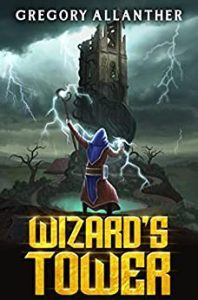 Wizard’s Tower by Gregory Allanther:
Wizard’s Tower by Gregory Allanther:
The humans call me Nemon Fargus. They call me wizard, and [Elementalist] and [Enchanter]. They call me teacher. They call me adventurer.
But I don’t care. Not anymore.
For more than 150 years I’ve served the Kingdom of Sena. Through four Kings and a Queen. Two wars and a rebellion. I’ve founded and taught at a magic school. I’ve fought against beast waves and dungeon breaks.
But now? Now, the one close friend I had left has passed. So, I’m done with their politics and their economics. The short and busy lives of humans are more burden than benefit on the weary soul of this half-elf.
Now, I’m looking for a refuge, a place that can well and truly be my own. Away from the growing cities and the bustling markets, away from the pointless wars, away from the eager students and the arrogant adventurers.
I’m seeking the peaceful life of a wizard in his tower, studying magic to advance my spellcraft…We’ll see if that happens.
Experience the start of a LitRPG Series from Gregory Allanther, the bestselling author of An Old Man’s Journey. With millions of views previously on Royal Road, this hit web serial is new and improved on Kindle & Audible.
 Adrift in Starlight by Mindi Briar:
Adrift in Starlight by Mindi Briar:
When set adrift in the universe, some things are worth holding onto.
Titan Valentino has been offered a job they can’t refuse.
Tai, a gender-neutral courtesan, receives a scandalous proposition: seduce an actor’s virgin fiancée. The money is enough to pay off Tai’s crushing medical debt, a tantalizing prospect.
Too bad Aisha Malik isn’t the easy target they expect.
A standoffish historian who hates to be touched, she’s laser-focused on her career, and completely unaware that her marriage has been arranged behind her back. This could be the one instance where Tai’s charm and charisma fail them.
Then an accidental heist throws them together as partners in crime.
Fleeing from the Authorities, they’re dragged into one adventure after another: alien planets, pirate duels, and narrow escapes from the law. As Tai and Aisha open up to each other, deeper feelings kindle between them. But that reward money still hangs over Tai’s head. Telling Aisha the truth could ruin everything…
Their freedom, their career, and their blossoming love all hang in the balance. To save one might mean sacrificing the rest.
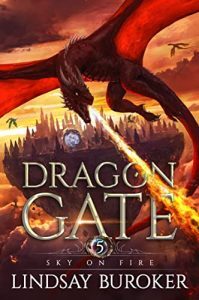 Sky on Fire by Lindsay Buroker:
Sky on Fire by Lindsay Buroker:
The dragons of eld, once benevolent allies to mankind, have been infested by a magical parasite that makes them cruel and aggressive. They’ve flown through the ancient portal to invade Torvil and plan to kill or enslave all of humanity.
If Jak and his allies can’t figure out how to destroy the parasite, a parasite the powerful dragons themselves were helpless to thwart, everyone they care about—everyone in the world—will be doomed.
 Panecea Genesis by L. Ana Ellis:
Panecea Genesis by L. Ana Ellis:
Mariela Stafford’s life just hit rock bottom. Her boss, the CEO of Panacea Corp, created a digital clone of himself, demoted Mariela, gave the clone her job, and told Mariela to train it. Now the clone wants her to help it kill the CEO.
In 2115, embedded chips, virtual reality, and the threat of extreme weather have led to a market for businesses that keep a person’s body alive in a habitation pod while the person lives entirely in the metaverse. But not everyone embraces technological advances– a group of people have adopted the tech of 2005 while isolating themselves from the temptation of advanced technology. Panacea Corp – the world’s most powerful corporation – connects both worlds through providing the metaverse, the pod warehouses, and the land to the technology resisters.
Mariela Stafford, a vice president for Panacea Corp, is demoted after her new boss assigns his digital clone to take over her job. Assisted by Amoco, an eccentric polymath who also works for the corporation, she schemes a way to get rid of the clone. To delete it, they’ll need to recruit a team to access an eighty-year-old server farm in a remote location—which would be a lot easier to do if the records on the location of the server farm hadn’t been lost.
This ‘earth’ opera—a tale with all the drama, expansiveness, and varied cast of a space opera, but set on earth—will appeal to anyone who’s ever felt out-of-control of the technology in their lives.
 Inquisitor’s Bane by Rachel Ford:
Inquisitor’s Bane by Rachel Ford:
The Inquisitor is dead. But Black Port’s problems are only just beginning.
Knight Protector Portia Daysen returns to the South, she’s a new woman, with new secrets. She means to continue the work of Black Wyvern, the secret order intent on rescuing elves and dragons from captivity and death.
Meanwhile, Captain Valia Iceborn struggles with her growing feelings for Portia – and how they may be impacting her judgement. Should she stay in Black Port, and risk detection? Or should she go to ground now, before the king’s men – and a new inquisitor – show up?
When the pair learn of the kidnapping of a rare black wyvern hatchling, a hatchling who can communicate with mortals and immortals alike, they realize his rescue must be priority number one.
But if there’s one thing the nations of North and South can agree upon, it’s the danger to their own power that such a wyvern poses. To rescue the missing hatchling, the two women will need to contend with more than inquisitors.
They’ll need to outwit and outrun the forces of two nations, hellbent on stopping them by any means necessary.
 Ghostly Shadows by Lily Harper Hart:
Ghostly Shadows by Lily Harper Hart:
Harper Harlow has it all, including a new business, a husband she adores, and a best friend she’s determined not to murder even though he’s determined to be the groomzilla to end all groomzillas. Life is good … until it’s not.
Everything is thrown into doubt when her former boyfriend, a grifter on trial for murder, escapes from the county courthouse and starts terrorizing Whisper Cove.
Her husband Jared Monroe is on edge. Quinn Jackson has proven himself to be a threat more than once, and it’s clear Quinn is gunning for Harper because he blames her for being caught in the first place. That means Zander and Shawn – who are in the midst of preparing for their wedding – have to move in so everybody is safe.
It’s a full house and the stakes are high. A dead courthouse guard is their only guide, and he’s not enough.
Harper is determined to get her happily ever after, as well as Zander’s too. That means they have to grapple with Quinn before the big day arrives.
Murder is on the menu and Quinn has nothing to lose. It’s a race to the finish – and down the aisle – and winner takes all.
Strap in. It’s going to be a bumpy ride.
I fell in love with a goth, but she’s a witch.
Starting school at Hawthorne University was not going well, until I met my classmate Alondra. Allie was different. She was goth. But she was also mysterious, confident and fun. I was into that. My name’s Liam. My friends call me Lee.
Things got weird after I accompanied her to her haunts. Poltergeists and demons attacked little girls. I watched Alondra help exorcise these ghosts, but some of their evil stuck to me.
Well, being attracted to a witch was one thing; dating one was quite another. It seemed the closer I got to Allie, the more her witchcraft endangered my friends. And my soul. You decide. I chronicled everything here in her book.
Alondra is a prequel to the internationally bestselling Hawthorne University Witch series. The novel takes place twenty years before Broomstick.
Content warning: Alondra is a new adult college paranormal romance containing profanity, sexual scenes, adult situations, and, of course, witchcraft.
 Ambassador: The Unfolding Army by Patty Jansen:
Ambassador: The Unfolding Army by Patty Jansen:
For three months, Cory and his team have hung with Asto’s military in orbit, watching as drone armies attacked Earth.
They could have helped more had Nations of Earth communicated with the fleet or if they could only find out where these drones come from, who controls them and from where. The enemy is smart, enmeshed with sections of Earth’s population and Asto’s military severely hamstrung by Nations of Earth playing chicken.
Three months ago, the president contacted Cory asking for help. The connection was interrupted and never re-established.
It’s as if they don’t want help.
Cory’s got gamra breathing down his neck with the requirement that Nations of Earth officially approves the presence of Asto’s military in orbit.
Something has to give.
He and his team return to a battle-scarred Earth on a hare-brained mission to talk to Nations of Earth, to check on the president, to get him to sign for approval. Getting there is hard. The state of the Nations of Earth assembly is deeply troubling. But getting out, that’s where it gets truly interesting.
 The Obanaax and Other Tales of Heroes and Horrors by Kirk A. Johnson:
The Obanaax and Other Tales of Heroes and Horrors by Kirk A. Johnson:
“The Obanaax” is a collection of two novelettes and two short stories that take the reader on a journey to the world of Aaduna on the great northern continent of Mbor. This novel’s imaginative sword and sorcery world, influenced by several West African languages, sets this book apart from other stories explored in this genre. These narrative elements, naming conventions, and heart-pounding prose makes “The Obanaax” an adventure that will ignite a passion for exploring this undreamed-of new world far beyond the last page has turned. These tales from far afield will introduce to you the adventurous daring-do of those unaccustomed to the monstrous chaos of the unnatural and, at times, its alien desires. An epic for those willing to brave far and away from the world we know.
Welcome to Dark Factory! You may experience strobe effects, Y reality, DJ beats, love, sex, betrayal, triple shot espresso, broken bones, broken dreams, ecstasy, self-knowledge, and the void.Dark Factory is a dance club: three floors of DJs, drinks, and customizable reality, everything you see and hear and feel. Ari Regon is the club’s wild card floor manager, Max Caspar is a stubborn DIY artist, both chasing a vision of true reality. And rogue journalist Marfa Carpenter is there to write it all down. Then a rooftop rave sets in motion a fathomless energy that may drive Ari and Max to the edge of the ultimate experience.Dark Factory is Kathe Koja’s wholly original new novel from Meerkat Press, that combines her award-winning writing and her skill directing immersive events, to create a story that unfolds on the page, online, and in the reader’s creative mind. www.Darkfactory.club
 Sun & Dream by J. Steven Lamperti:
Sun & Dream by J. Steven Lamperti:
Anise has power in her dreams – too much power.
When your dreams can change the world, you need to learn to control them.
Anise’s uncle Sebastian takes her to the Academy, the school where the wizards of Liamec learn to use their powers.
But the people in Anise’s small village are not the only ones who notice the young girl’s abilities. Who is the Watcher, the malevolent presence Anise feels in her dreams, and why is Helios, the sun-god, protecting her?
While Anise studies the ways of the wizards, a dark secret that hangs over the founding of the Academy threatens to unravel reality and destroy the land of Liamec.
Centuries ago Tomas made a promise and has kept it out of cowardice. He has lived under the radar for all this time, hiding from the authorities where he can. Recipient of a terrible gift, his belief that he is the only one like himself is about to be exploded. The gods’ favoured are corrupt, power hungry and know how to find him.
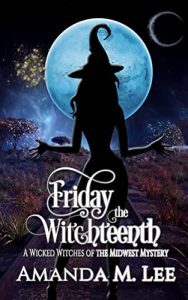 Friday the Witchteenth by Amanda M. Lee:
Friday the Witchteenth by Amanda M. Lee:
Bay Winchester is newly married and happy. Things have been quiet since she returned from her honeymoon, which means trouble is just around the corner. When it comes, it takes the form of a despondent man on a bridge. Despite her best efforts, Bay and the hostage negotiator can’t save him, and death is swift.
That should’ve been the end of it, but a weird symbol on the dead man’s hand piques Bay’s interest, and when the negotiator turns up sick with the same symptoms, she knows that they have a problem on their hands.
Suicide as a contagion? It’s not the fight Bay was expecting, and it’s definitely not the one she was looking for. Still, it’s the problem that keeps on giving … especially when it spreads to Mrs. Little.
In her heart, Bay knows that she shouldn’t care about the woman who has hurt her family at every turn. Ignoring the problem isn’t an option though. If she stands back and does nothing in an attempt to end the chain, she’ll never be able to live with herself. If she gets too close, she could get infected herself.
Bay has never doubted her magic, but the current fight is out of her wheelhouse. Magic is at the core of what’s happening, but their enemy is invisible.
The Winchester witches have never met an enemy they can’t fight … until now. Will they be able to pull together and save Hemlock Cove? Or is the town doomed to fall to a curse without a name and an evil without a soul?
Strap in, because the answer is more than anybody is expecting, and if everybody is to survive, the fight will have to move to an entirely new level.
The game is on. In this one, the winner will take all.
It only takes one night for the world to turn on its head…
Finishing my second degree was supposed to be a quiet time of wrapping up my academic work and maybe making a friend or two before everyone left town. That was before the monsters started attacking.
I’ve always ignored the strange occurrences that tend to happen around me, but now these creatures are hunting me, everything I touch is erupting into flame, and all I’ve got to help is a guy I barely know, his reclusive sister, an invitation to train with a secretive magical faction, and a strange necklace that apparently belongs to the magical world’s most wanted…
I’m not used to trusting anyone, but as monsters close in, I don’t think I have a choice.
 Iron Paws and the Tinker’s Forged Marriage by Juli D. Revezzo:
Iron Paws and the Tinker’s Forged Marriage by Juli D. Revezzo:
A year ago, Vesta Bartlett received a rather unusual assignment.
Now, as if perfecting her clockwork puppies for Queen Victoria weren’t enough, a surprise invitation to present them to the Texas Republic president makes Vesta question a number of things, including will the president accept the clockwork from a woman? Unsure, she agrees to allow Henry to go along, as her spokesman and husband, regardless of how her father may feel about a fake marriage.
But they have bigger problems than her father’s anger when an anti-alchemist group takes issue with her clockwork creations and decide they need to stop Vesta’s work. By any means, no matter how violent.
 Speed of Dark by Patricia Ricketts:
Speed of Dark by Patricia Ricketts:
Mary Em Phillips has decided to end it all after losing her beloved Mamie, who raised her; her husband, Jack, who has left her for another woman; and her only son, Petey, who has died as a result of a freak bacterial infection. But when Mosely Albright, a black man from Chicago’s South Side, comes to her back door one morning needing a drink of water and seeking directions back to the train, her plans are derailed . . . to the chagrin of Mishigami (so named by the Ojibwe, also known as Lake Michigan), who has been trying to lure Mary Em into his icy depths in the hopes that she will save him.
Mary Em wants nothing more than to end her anguish. Mosely is searching for the love he’s been missing most of his life. And Mishigami—who fears he is dying from rampant pollution and overfishing—seeks a champion.
A story of friendship, survival, connection and the unquestioning power of nature told through three distinct voices, Speed of Dark affirms a love of humanity that transcends all else, including race and background.
 The Exorcist’s House by Nick Roberts:
The Exorcist’s House by Nick Roberts:
This psychological thriller follows a family to their Appalachian farmhouse, where they encounter an unimaginable horror.
In the summer of 1994, psychologist Daniel Hill buys a rustic farmhouse nestled in the rolling hills of West Virginia.
Along with his wife and teenage daughter, the family uproots their lives in Ohio and moves south. They are initially seduced by the natural beauty of the country setting. That soon changes when they discover a hidden room in the basement with a well, boarded shut and adorned with crucifixes.
Local legends about the previous owner being an exorcist come to light, but by then, all Hell has broken loose.
This 1990s horror novel is perfect for fans of family thriller books, stories of demonic possession, exorcism fiction, the occult, or thrillers like The Exorcist, A Head Full of Ghosts, and The Amityville Horror.
Proudly represented by Crystal Lake Publishing—Tales from the Darkest Depths.
A peaceful world in the crosshairs
A rising threat armed by an old foe
A call to arms she can’t ignore…
Admiral Kira Demirci lost the coin toss with her second-in-command and was supposed to be taking a holiday. That meant waiting in the Redward System while Memorial Force’s new carrier Huntress was commissioned and turned over to the mercenary space fleet.
But when a stranger arrives looking to hire Memorial Force to protect her homeworld, Kira finds money, boredom and altruism combining to bring her into action. The majority of her fleet is elsewhere, but she has two heavy warships, including Huntress. More than enough to protect the pacifist system of Samuels from their neighbors.
Those neighbors were armed by Kira’s old foes in the Brisingr System, and she smells the hand of the Equilibrium Institute behind the scheme. A chance to protect the innocent and frustrate two old foes at once is hard to turn down—and even if things go wrong, the rest of her fleet is on their way.
She’s planned for everything. Hasn’t she?
 City in the Sky by Glynn Stewart:
City in the Sky by Glynn Stewart:
“Killing a man isn’t an easy thing to live with, no matter the cause.”
Erik Tarverro is a skilled blacksmith, a better swordsman—and hated for his mixed aeradi parentage. Denied mastery of his craft in the human city he grew up in, he accepts a risky contract from a dangerous stranger.
With new enemies at his heels, he leaps at the chance to join his father’s people in the sky city of Newport. Despite his human blood, he finds his place among the aeradi: heir to an ancient noble family.
His duty leads him to sailing the skies and learning what it means to lead soldiers. But Erik’s enemies will have blood, and the peace between his people and the Draconan dragon riders is like a powder keg. All it would take is one spark—and dragons will fly on his newfound city in the sky.
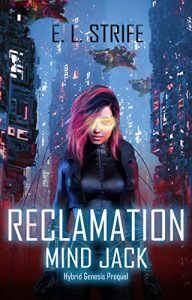 Reclamation Mind Jack by E.L. Strife:
Reclamation Mind Jack by E.L. Strife:
Marci, a super soldier and escapee of the Astral’s bio-enhancement military program Zedger, has found a new purpose in rescuing others like her. But she can’t do it alone, and not without parts. Marci must travel to the last standing city of Tellurians in the irradiated expanse of Zion. There, in EsoTerra, she must fight for her right to trade with others for what she requires.
She tries to hide her identity, mask her skills, play down her expertise, but too many have heard rumors of her. Marci can’t hide from the truth forever.
Soon, she finds herself helping other soldiers dumped from Zedger. Recent “disposals” have lost their minds to the Genesis program Astrals use to control their creations. Marci must deep dive the soldiers’ cerebral enhancements to figure out why and salvage everyone she can.
What she discovers when searching Genesis streams alerts Astrals to her position. Lead rain soon falls from the sky in the form of BloodTitans.
Can Marci save the soldiers and her people? Or is this the Tellurians’ last stand?
 With Slight Tremors by Ed Teja:
With Slight Tremors by Ed Teja:
It’s time to take a break from the world you think you know and to step through into another one. These five stories offer a guided tour of new possibilities and different places. They rely on magic, science, and sleight of hand, and will betray your trust at every opportunity. But just because they are fantastic, doesn’t mean they aren’t real (somewhere).
You can stay tucked away on a safe perch and let this book unveil the genre-bending consequences of rather minor changes to a world that might be the one you live in, or might not; you can follow the way events unravel when cause and effect aren’t quite so boringly predictable.
Stories of ideas are, however, always dangerous. Consider yourself warned.
 Martian Jump Gate by James David Victor:
Martian Jump Gate by James David Victor:
Humanity has opened a door that allows for instantaneous travel through the stars. What they find on the other side might mean the end of all mankind.
The invention of jump-gates has allowed instantaneous travel throughout the solar system, and beyond. Captain Shoji Mora will lead the first expedition through the jump-gate to Mars in a gigantic space robot known as Tin Man. Their mission soon turns from mining and exploration to defending humanity from an alien invasion. Can the giant space robot defend mankind from certain destruction at the hands of a superior alien armada?
Mars Jump Gate is the first book in the Tin Man Space Opera Adventure. If you like fast-paced sci-fi adventures, make Tin Man your next epic space adventure.
 The Orion Abduction by Dylan White:
The Orion Abduction by Dylan White:
He’s either the key to our evolution or our destruction. And they’re coming for him.
For most of his fifteen years, Joshua Fox believed he was being abducted by aliens.
Just searching for normalcy in his small Kansas town, he discovers he’s unwittingly been involved in something much bigger and everything he thought he knew is now in question.
All Josh really knows is he must find out the truth before it’s too late—not just to save himself and his friends, but the entire world.
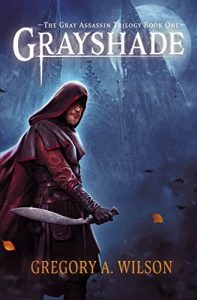 Grayshade by Gregory A. Wilson:
Grayshade by Gregory A. Wilson:
For ten years, the assassin Grayshade has eliminated threats to the Order of Argoth, the Just God. Within the towering walls of Cohrelle, all bow to the Order’s authority, even while the city officials publicly distance themselves from its actions.
As the supreme executor of the Order’s edicts, Grayshade dispatches his targets with protocol and precision. But when an assignment breaks these rules, he does the most dangerous thing an Acolyte of Argoth can do: he asks why. Now a target of the Order he so long served without question, he must use all of his skills not only to kill . . . but to stay alive.
Grayshade is a novel of violent faith and shifting loyalties, a story about whether we can rise above our pasts to craft new futures.
May 29, 2022
Indie Crime Fiction of the Month for May 2022

Welcome to the latest edition of “Indie Crime Fiction of the Month”.
So what is “Indie Crime Fiction of the Month”? It’s a round-up of crime fiction by indie authors newly published this month, though some April books I missed the last time around snuck in as well. The books are arranged in alphabetical order by author. So far, most links only go to Amazon.com, though I may add other retailers for future editions.
Our new releases cover the broad spectrum of crime fiction. We have cozy mysteries, animal mysteries, historical mysteries, Jazz Age mysteries, paranormal mysteries, crime thrillers, psychological thrillers, action thrillers, adventure thrillers, horror thrillers, police procedurals, detective novels, police officers, ex-cops, private investigators, amateur sleuths, thieves, con artists, serial killers, organised crime, drug dealing, human trafficking, heists, sleazy megachurch ministers, crime-busting witches, crime-busting socialites, crime-busting ghosts, crime-busting dogs, deadly writer retreats, murder and mayhem in London, Rutland, the Pacific Northwest, Florida, Texas, Kansas, Calgary and much more.
Don’t forget that Indie Crime Fiction of the Month is also crossposted to the Indie Crime Scene, a group blog which features new release spotlights, guest posts, interviews and link round-ups regarding all things crime fiction several times per week.
As always, I know the authors at least vaguely, but I haven’t read all of the books, so Caveat emptor.
And now on to the books without further ado:
 Murder Over the Cold Grave by Blythe Baker:
Murder Over the Cold Grave by Blythe Baker:
When a serial killer draws Lillian Crawford into a deadly game, she and Eugene Osbourn must team up one final time to thwart their mysterious foe. But will they stop the murderer’s twisted game in time to prevent one more death?
 Iconoclast by Laurie Buchanan:
Iconoclast by Laurie Buchanan:
Burdened by the pressing weight of survivor’s guilt, Sean McPherson, an ex-cop, is desperate for redemption. At Pines & Quill, a writer’s retreat in the Pacific Northwest, he and his fiancée, Emma Benton, are planning their lives together. He wants to go back into law enforcement. She plans to walk again.
Georgio “The Bull” Gambino, head of a Seattle-based crime family, has a long reach. Like cockroaches, his minions infiltrate even the most inaccessible of places to do his bidding. With Seattle to the south, the Canadian border a stone’s throw to the north, and Bellingham Bay—a gateway to the Pacific Ocean—immediately to the west, Bellingham is the ideal location for the Gambino crime family to traffic drugs, weapons, and humans. But McPherson’s in Gambino’s way, which means he must be eliminated.
The writers in residence at Pines & Quill include an Afghanistan War veteran, a professional photographer, a civil rights attorney, and a gourmet chef. But McPherson suspects that there’s more going on than the joy of creating plot twists. Is one of them conspiring murder outside the pages of their manuscript?
 Murder With Daffodils by Beth Byers:
Murder With Daffodils by Beth Byers:
Vi and friends have traveled to a nearby village to see the flowers. These aren’t just any spring bulbs. They are fields of flowers planted as a living love poem. People who know of their existence travel from miles around to witness the beauty.
If only they could be surprised when they discover a mystery along with the blossoms. Vi and friends are also not surprised when, once again, they can’t leave things alone. This time they’re intrigued by the very person the flowers were planted for, and the one who planted them.
As the case progresses, they wonder if it’s a romance or a horror story. Violet uncovers clues and chases down secrets, delving into the darkness amidst the beauty. Only as they draw closer to the killer, they discover that maybe they don’t want to know what happened after all.
 The Megachurch Heist by L.W. Cadle:
The Megachurch Heist by L.W. Cadle:
1.4 million in stolen cash. It should be a simple heist to steal from a thief. What could go wrong?
Darla Doyle could have retired with the money she made from her last heist. But her partner in crime, Flynn, comes to her with an offer she can’t refuse.
Andrew Curtis, a sleazy megachurch minister, has stolen 1.4 million in donations and hid the cash, and Flynn knows exactly where. Darla has a personal grudge to settle with religious scammers, so she signs on.
But when they get to the Kansas church, posing as a preaching couple wanting business advice, Darla finds it nearly impossible to keep up the persona they’ve created for her. She’s no actress, she’s a getaway driver! And worse, the megachurch’s head of security, Silas Flecke, is far sharper an operator than she expected to encounter.
Flecke is a pro at securing the church against crime. Darla and Flynn are pros at stealing. Who will come out on top when they break into the church at night to retrieve the stolen cash?
 Watch Your Back by Stacy Claflin:
Watch Your Back by Stacy Claflin:
Even perfect neighborhoods have deadly secrets.
Ariana and Damon moved to the gated neighborhood of Rosy Hills to leave behind their traumatic pasts. Now they have their dream jobs and are part of a tight group of friends. All of that crumbles when their neighbor Rita disappears without a trace.
Now it looks like one of their own could be a killer. Ariana and Damon must figure out who it is, or they risk never finding Rita alive. If they don’t reach her in time, they could all end up dead…
An elderly woman collapses and dies during a Sunday morning church service in Oakham. But things aren’t quite as innocent as they seem.
Within hours, there’s a second unexplained death in Rutland. Then a third. But the victims appear to be completely unconnected.
With the body count rising by the day, DI Caroline Hills and DS Dexter Antoine need to uncover the link before more innocent people die.
Only one thing is certain: a killer walks the streets of Rutland. But no-one knows who the next victim will be, when they will be killed — or why.
 The Bus to Beulah by E.C. Hanes:
The Bus to Beulah by E.C. Hanes:
On her way to a new job in America, Maria Puente accidentally discovers a human trafficking ring. Fearing exposure, the American company that manages the operation—with the help of their Mexican partners—kidnaps Maria.
Maria’s disappearance triggers a desperate search, by her family and local law enforcement, to find her before the kidnappers can permanently dispose of her. As the investigation unfolds, long-time Hogg County high sheriff Will Moser confronts Albert Waters, a powerful businessman who Will suspects knows about Maria’s disappearance—but Albert and his Mexican cartel partners prove to be brick walls.
At the urging of his wife, Lana, Will calls on Elijah Kahn, a man he got to know while serving in Vietnam who now runs one of the largest international security firms in the world. The idea of working with men who are rightly known as mercenaries troubles Will, but he knows he’ll never find Maria without Elijah’s help—and when Lana reminds Will of the debt they owe to Tomas Delgado, Maria’s uncle, his hesitation evaporates.
Organized in an hour-by-hour structure, The Bus to Beulah is a taut thriller that culminates in a massive, heatrt-pounding chase to save Maria—before she disappears forever.
 Ghostly Shadows by Lily Harper Hart:
Ghostly Shadows by Lily Harper Hart:
Harper Harlow has it all, including a new business, a husband she adores, and a best friend she’s determined not to murder even though he’s determined to be the groomzilla to end all groomzillas. Life is good … until it’s not.
Everything is thrown into doubt when her former boyfriend, a grifter on trial for murder, escapes from the county courthouse and starts terrorizing Whisper Cove.
Her husband Jared Monroe is on edge. Quinn Jackson has proven himself to be a threat more than once, and it’s clear Quinn is gunning for Harper because he blames her for being caught in the first place. That means Zander and Shawn – who are in the midst of preparing for their wedding – have to move in so everybody is safe.
It’s a full house and the stakes are high. A dead courthouse guard is their only guide, and he’s not enough.
Harper is determined to get her happily ever after, as well as Zander’s too. That means they have to grapple with Quinn before the big day arrives.
Murder is on the menu and Quinn has nothing to lose. It’s a race to the finish – and down the aisle – and winner takes all.
Strap in. It’s going to be a bumpy ride.
PI Kelly Pruett finally feels like she’s coming into her own. With her personal life well on track, a gig uncovering what drove a client’s granddaughter underground could be good for business. But after her undercover operation at the homeless shelter reveals rampant drug dealing, she’s suddenly kicked off the case… just as another girl goes missing.
Vowing to expose the truth even if it means pro-bono work, Kelly is taken aback when her half-sister helps her hunt down answers in a tent city brimming with distrust. When her investigation doesn’t move quickly enough to save a second woman from a vicious murder, Kelly doubles her efforts unwilling to accept defeat.
 Friday the Witchteenth by Amanda M. Lee:
Friday the Witchteenth by Amanda M. Lee:
Bay Winchester is newly married and happy. Things have been quiet since she returned from her honeymoon, which means trouble is just around the corner. When it comes, it takes the form of a despondent man on a bridge. Despite her best efforts, Bay and the hostage negotiator can’t save him, and death is swift.
That should’ve been the end of it, but a weird symbol on the dead man’s hand piques Bay’s interest, and when the negotiator turns up sick with the same symptoms, she knows that they have a problem on their hands.
Suicide as a contagion? It’s not the fight Bay was expecting, and it’s definitely not the one she was looking for. Still, it’s the problem that keeps on giving … especially when it spreads to Mrs. Little.
In her heart, Bay knows that she shouldn’t care about the woman who has hurt her family at every turn. Ignoring the problem isn’t an option though. If she stands back and does nothing in an attempt to end the chain, she’ll never be able to live with herself. If she gets too close, she could get infected herself.
Bay has never doubted her magic, but the current fight is out of her wheelhouse. Magic is at the core of what’s happening, but their enemy is invisible.
The Winchester witches have never met an enemy they can’t fight … until now. Will they be able to pull together and save Hemlock Cove? Or is the town doomed to fall to a curse without a name and an evil without a soul?
Strap in, because the answer is more than anybody is expecting, and if everybody is to survive, the fight will have to move to an entirely new level.
The game is on. In this one, the winner will take all.
 Scavenger Hunt by Duane Lindsay:
Scavenger Hunt by Duane Lindsay:
It looked like taking candy from a baby. Until it didn’t…
For a con artist like Dani Silver, the mark’s low-hanging fruit—a recently signed basketball prodigy suddenly worth millions—and too young and naïve to know who to trust. Only one problem–so many people are already trying to scam him there’s literally no way to get to him.
Except, that is, to make a deal with the devil— aka Greville Norquist, a fixer with a reputation as the prince of darkness. The deal: Greville will arrange an intro and in return, Dani must provide him with four seemingly worthless items scammed or stolen from people Greville specifies—one of them being a snuffbox.
It’s a perfect set-up for author Lindsay to work his comic magic, deftly twisting one plot around the other like a couple of puppies in a box. But there are two obstacles— first, the snuffbox owner turns out to be nearly as hard to find as the mark.
And second, the mark turns out to be a sweet kid with an even sweeter fiancée— Leticia’s so lovely Dani’s ally, Foster Stevens the gay apy, more or less falls for her. In fact, pretty soon the whole gang balks at scamming these two. And Dani herself has taken a vow never to cheat a good guy.
So how are they supposed to turn a profit on this one?
As it turns out, it’s the least of their worries—Greville’s declared war on them.
 Dog’s Honest Truth by Neil S. Plakcy:
Dog’s Honest Truth by Neil S. Plakcy:
Steve and Rochester seek the truth about a neighbor’s murder
There’s a new dog in town – a golden retriever named Luke, in training to be a seeing-eye dog. He and Rochester immediately bond, but there’s something odd about Luke’s human, Ben Ji. How can someone so young afford an expensive townhouse on Sarajevo Way? When Ben is shot, Steve begins to discover the lies he has been telling.
Steve’s also forced to tell the truth about his past, when he deals with a student plagiarist at Eastern College, a professor locked in the stone age, a climate activist with dangerous habits, an angry bartender—and a rifle-wielding assassin.
Will he and Rochester be able to dig up the clues to all these mysteries? Or will a deadly killer go unpunished?
 The Exorcist’s House by Nick Roberts:
The Exorcist’s House by Nick Roberts:
This psychological thriller follows a family to their Appalachian farmhouse, where they encounter an unimaginable horror.
In the summer of 1994, psychologist Daniel Hill buys a rustic farmhouse nestled in the rolling hills of West Virginia.
Along with his wife and teenage daughter, the family uproots their lives in Ohio and moves south. They are initially seduced by the natural beauty of the country setting. That soon changes when they discover a hidden room in the basement with a well, boarded shut and adorned with crucifixes.
Local legends about the previous owner being an exorcist come to light, but by then, all Hell has broken loose.
This 1990s horror novel is perfect for fans of family thriller books, stories of demonic possession, exorcism fiction, the occult, or thrillers like The Exorcist, A Head Full of Ghosts, and The Amityville Horror.
Proudly represented by Crystal Lake Publishing—Tales from the Darkest Depths.
 Elusive Charity by Wayne Stinnett:
Elusive Charity by Wayne Stinnett:
Since the recent death of a wealthy but perverted businessman, Charity Styles has been hiding in plain sight, as if challenging anyone to come after her.
She’s on her own once more, living day to day on her beloved Wind Dancer, anchored near a quaint little Gulf Coast town in the Florida Panhandle. But when the son of a fishing client ends up dead, the father’s employer hires Charity to find the person responsible.
Intrigue mounts faster than the list of suspects and Charity finds new purpose and direction, and possibly a guide. But will her new outlook make her fall prey to the local crime boss? Very few know of her abilities and many have come up short in trying to take her. Will this be Charity’s final downfall from grace?
 Murder at the Circus by Lee Strauss:
Murder at the Circus by Lee Strauss:
Murder’s a spectacle!
When Ginger Reed ~ aka Lady Gold ~ and Basil Reed’s son Scout runs away to join the circus, it’s not all fun and games. As a disgruntled teen unhappy at boarding school, Scout intends to work with his cousin Marvin, newly (and dishonourably) discharged from the navy. An animal lover at heart, Scout is tickled to assist the animal trainer and develops a particular bond with the matriarchal elephant, Tulip.
The big top event pleases the crowds, but when a performer dies under suspicious circumstances, Scout and Tulip find themselves in real, three ring trouble!
 Pineapple Podcast by Amy Vansant:
Pineapple Podcast by Amy Vansant:
Pineapple Podcast is packed full of Pineapple Port surprises!
Charlotte hunts a killer with a curious cookie-cutter calling card who seems to be out to impress the local true-crime podcaster. The work keeps her from concentrating on the fact her boyfriend has been acting strange…it seems Declan is ready to make a few major life decisions.
Meanwhile, Mariska and Darla take over a local restaurant while the owner’s out of town, and can’t help but add a few things to the menu… bad idea, since the owner belongs to a true crime club that roots for the killers…
Mix in an earbud-wearing puppy, a starry-eyed deputy, and white-knuckle action and you’ll find yourself wanting to move to Pineapple Port…again!
 Immersed in the View by P.D. Workman:
Immersed in the View by P.D. Workman:
A Wake Up Call
Detective “Parks” Pat is back. Now an established and accepted member of the homicide squad, she unexpectedly brings a new case to the table when she stumbles across a body as Canada Day dawns. While it was initially assumed to be an accidental drowning, the autopsy results say otherwise.
Margie is soon off and running, but the lack of witnesses has her going in circles. Meanwhile, the brass wants the investigation put to bed before the city is flooded with Calgary Stampede tourists and dignitaries.
May 28, 2022
Star Trek: Strange New Worlds Meets the “Children of the Comet”
It’s time for the next Star Trek: Strange New Worlds review. Reviews of previous episodes (well, just one so far) may be found here.
Warning: Spoilers under the cut!
The second episode of Star Trek: Strange New Worlds kicks off with throwing a dinner party in his quarters. Invited are the bridge crew and other officers as well as Cadet Uhura who shows up in her dress uniform and is of course completely overdressed, thanks to a prank by helmsman (or rather helmswoman) Erica Ortega, who herself wears her favourite cargo pants and combat boots combo. This is not the end of the humiliation for poor Uhura, because next she manages to offend Hemmer, the Enterprise‘s chief engineer, who happens to be an albino Andorian and blind, but really does not like to be treated as if he were impaired, because he’s not, thank you very much.
Science fiction from the 1960s and 1970s is often very ableist – see The Ship Who Sang by Anne McCaffrey and “Stranger in Paradise” by Isaac Asimov, both of which horrified me with their casual dismissal of disabled people. Even Star Trek was not immune and the Original Series episode “The Menagerie” is another example of casual 1960s ableism, because of the way it portrays Pike’s life as a disabled person after his near-fatal accident. This even spills over into Strange New Worlds, because Discovery made the stupid and unnecessary decision to give Pike a prophetic vision of his ultimate fate, which has come up in every episode so far, though to be fair, it was only two episodes. But considering that Strange New Worlds finds itself saddled with the ableist legacy of “The Menagerie”, it’s good that they have added a disabled character to the cast who lives a full life. Even if Hemmer hasn’t been given a whole lot to do so far.
Uhura perks up, when she chances to hear a Kenyan folk song in the music on rotation at Pike’s dinner party. In fact, Poke likely put that piece of music in rotation to get Uhura to loosen up a little. It works, too, because Uhura tells Pike and the assembled crew a bit about herself. She is from Kenya (which we already knew) and a linguistic prodigy who speaks thirty-seven languages. She was planning to study xenolinguistics at the University of Nairobi, when her parents and her brother died in a shuttle crash, leaving young Uhura adrift. She goes to live with her grandmother, a retired Starfleet officer who encourages her to apply to Starfleet Academy, which Uhura does. Though at this point in time, Uhura is still not sure if Starfleet truly is the right path for her. This brief scene gives us more background on Uhura than we got in three season of the Original Series plus one season of the Animated Series and six movies, as Keith R.A. DeCandido points out in his review at Tor.com.
Of course, dinner party scenes are ideal for characterisation and so Spock also gets a nice character moment, when Pike recounts a funny story about chasing some alien and tripping over his own pants and everybody laughs except Spock, who just looks delightfully puzzled, since he cannot grasp what’s supposed to be so funny about somebody else’s misfortune. “Sometimes, things go so disastrously wrong that you just have to laugh,” Pike says.
I have always been sceptical about recasting iconic Original Series characters like Spock or Uhura, but Ethan Peck absolutely nails Spock in a way Zachary Quinto in the J.J. Abrams movies never did. And Celia Rose Gooding makes an excellent young Uhura. Both actors also nail the relationship between Spock and Uhura, such as when Spock tells Uhura that if she isn’t really sure that Starfleet is for her, she should either become certain of her place or move on and make way for someone else. In turn, Uhura teases Spock about Christine Chapel’s obvious liking for him, which confuses poor Spock very much.
The Enterprise is observing a comet, when they realise that the comet will hit a planet, which is inhabited by an intelligent, if primitive species. Of course, the Prime Directive forbids directly interfering in that species’ development, but Pike is not willing to let them die either – something that Picard has to be persuaded to do for another doomed alien species in the (terrible) Next Generation episode “Homeward”. That is, not the episode itself is terrible – it’s okay actually – but the fact that everybody in Starfleet, including moral paragon Jean-Luc Picard is fully willing to let the aliens die, if not for the intervention of Worf’s human foster brother Nikolai Rozhenko. Tor.com‘s Keith R.A. DeCandido explicitly calls out “Homeward” as well as a Voyager and an Enterprise episode to point out that no, the Prime Directive is not actually a license to commit genocide by neglect, even if it has occasionally been interpreted that way. Indeed, as Pike explicitly says in this episode, “We don’t interfere in the development of species, but we also don’t just let them die.”
And so Pike comes up with a plan to launch some photon torpedoes and nudge the comet away from the inhabited planet. “Come on, let’s save a planet before breakfast”, he says. There’s only one problem. When the Enterprise fires its torpedoes at the comet, they are repelled by a force shield.
Comets usually don’t have force shields, but a closer scan of the comet reveals not only a force shield, but also some kind of building or structure on the surface. The force shield would likely also hold off a shuttle, but it only activates, when some object is aimed at the comet. Beaming an away team down to the comet’s surface to figure out how to deactivate the force shield and/or move the comet should be possible. This away team consists of Spock as chief science officer, La’an Noonien Singh as chief of security, Lieutenant Sam Kirk (older brother of James Tiberius), since he is a xenobiologist, and Cadet Uhura, since she is the closest thing to a xenolinguist the Enterprise has.
Uhura understandably freaks out – she’s just a cadet after all and not supposed to go on away missions – but both Spock and Pike tell her that she is the only person for the job they have on board. Again, Celia Rose Gooding does a great job portraying Uhura oscillating between sense of wonder (“I’m standing on the surface of a comet”) and sheer panic.
The away team ventures into the structure on the surface of the comet, which is obviously man or rather alien-made. The entire building is covered in markings and at the center is a giant egg, which should make anybody who has seen Alien very uneasy. “Are those markings linguistic or just ornamental?” Sam Kirk asks Uhura, who realises that as the resident xenolinguist, she is the one who is supposed to figure this out. Uhura finally detects a repeating sequence in the markings, which she deduces as a code. Sam Kirk decides to try it out – apparently, he is as impulsive as his more famous brother – and promptly gets blasted by the egg. He lands on his back on the floor, grieveously wounded, in a shot very reminiscent of the first (and last) time we saw Sam Kirk on screen, fifty-five years ago in the Original Series episode “Operation: Annihilate!”
La’an hails the Enterprise and tells them to beam everybody out now, but – surprise – the force shield reactivates and the away team cannot be beamed out. They’re stuck, though La’an manages to stabilise Sam Kirk. Well, we know he wasn’t going to die here, because we’ve already seen him die in “Operation: Annihilate!” some ten to fifteen years later.
Understandably, Uhura freaks out even more. Spock attempts to give her a pep talk, which works just as well as you’d imagine. In order to calm herself, Uhura starts humming a folk song from her home, which causes the marking on the wall and the egg to light up. The comet is clearly responding to her.
Meanwhile, the Enterprise has problems of its own, because a giant spaceship suddenly appears out of nowhere and fires on the Enterprise. When Pike hails them, the alien captain informs him that he and his people are the Shepherds of the comet, which they call M’hanit. The aliens are convinced that M’hanit is no mere comet, but a life-giving, all-knowing deity that must not be tampered or interfered with. Pike apologises to the Shepherds and points out that M’hanit is currently on a collision course with an inhabited planet and that this impending collision will not only wipe out the planet but also destroy M’hanit itself and all the Enterprise was doing was trying to prvent that collision. The Shepherds, however, are not impressed. M’hanit knows best and if M’hanit decides to strike the planet and commit suicide in the process, then so be it. The Shepherds are also not at all amused that the Enterprise landing party has desecrated the temple on the surface of M’hanit and warn against further interference.
Now the Shepherds are clearly religious zealots, though – as Keith R.A DeCandido notes – their non-interference policy is not that different from the Prime Directive, though Starfleet usually isn’t that fanatic about it. However, Pike is just as determined to hold true to Starfleet’s ideals of saving those in need and that’s what he will do, Shepherds be damned.
Meanwhile, back on M’Hanit, Uhura has deduced – based on the fact that the comet responded to her humming – that the mysterious markings are a form of musical notation. And since music is also mathematics, she manages to decode the markings and begins to hum the melody they represent – with some help from Spock, since Sam Kirk is still unconscious and La’an doesnt sing. It works, too, because the M’hanit deactivates his force shield, allowing the Enterprise to beam the team back up.
Unfortunately, this also infuriates the Shepherds – so much for “M’hanit knows best”. And so they start firing at the Enterprise and unfortunately, they have the bigger guns. However, the Enterprise has Erica Ortegas, who flies the ship into the comet’s tale and closer to M’hanit, close enough that the Shepherds stop firing for fear of hitting the comet. Pike then orders all systems except for life support shut down. Then he hails the Shepherds and tells them that the Enterprise is unable to manoeuvre due to the battle damage it sustained. He then asks the Shepherds to tow the Enterprise out of the comet’s tail and promises that the Enterprise won’t touch the comet. Which it doesn’t.
While the Shepherds are busy with towing the Enterprise, a lone shuttle emerges unnoticed from the Enterprise‘s shuttle bay. The shuttle is piloted by Spock and its hull radiates heat. Spock then flies very close to M’hanit in order to melt some of its mass off and nudge the comet into a path that will keep it from colliding with the planet. The manoeuvre is successful, too, and Spock even laughs out loud, because – to quote Pike – sometimes things go so disastrously wrong that you can only laugh about it. The special effects of the space battle, the chase through the comet’s tail and Spock’s flight are very impressive as well. Episode 1 was fairly low on special effects and set mostly on a planet that looks eerily like 21st century California, probably because they saved up the special effects budget for this one.
However, M’hanit is not just nudges off course, the melted off chunk of ice enter the atmosphere of the planet, injecting a lot of water vapour into the atmosphere and causing rains on the arid planet, which will help the people living on its surface. M’hanit has indeed brought life to the desert world. The Shepherd captain contacts Pike again and smugly says that Pike has now seen the power and wisdom of M’hanit. Pike does not contradict him, because it is no use arguing with zealots.
Meanwhile, Uhura has decoded the musical notes from M’hanit and finds that they not only describe Spock’s exact flight path but also the exact shape of the chunk of ice that Spock broke off the planet. But how could M’hanit and whoever built the structures on its surface know that, especially since Uhura recorded the music from M’hanit well before the plan to nudge the comet off course without touching it was even formed.
So is M’hanit truly all-knowing and a messenger of some alien deity or – since this is Star Trek – highly advanced being and did he just need a little help from Starfleet to fulfill his mission? The episode never really answers those questions. However, the experience with M’hanit reminds Pike of his terrible ultimate fate once more. Earlier in the episode, he told Number One that he knew the names of all the cadets whose lives he saved, so he asks the computer to look them up and is of course faced with photos of approximately eight to ten year old kids.
As for Uhura, Spock tells her that if she decides that Starfleet is the path she wants to take, this will be a win for Starfleet. Of course, as James Whitbrook points out in his review at io9, we already know that Uhura will stay in Starfleet and aboard the Enterprise and that she will be communications officer by the time we meet her again. Nonetheless, this episode not only gave Celia Rose Gooding a chance to shine, but also fleshed out Uhura’s character and used one of the few things we do know about her from the Original Series, that she loves singing and music, to do so. Plus, Uhura gets more to do in this episode than in most episodes of the Original Series.
This was another great episode, which not only showed us the Enterprise crew “sciencing the shit” out of a problem. Even better, it was a linguistic first contact story and I have a soft spot for those. In general, Star Trek: Strange New Worlds continues to be highly enjoyable and probably the most Star Trekky of the 21st century Star Trek series. This is what Discovery should have been like, when the decision to set the show approx. ten to fifteen years before the Original Series was made. Discovery has since found its own path, though it is still great to finally get the show that Discovery should have been, but wasn’t.
May 27, 2022
A Trio of Links and News
Here’s a brief link post, since I have a couple of things to announce:
For starters, my latest article is now live on Galactic Journey. This one is about a forgotten tragedy from fifty-five years ago, a devastating fire at the À l’Innovation department store in Brussels on May 22, 1967, which not only gutted a historic Art Noveau building, but also killed more than three hundred people (the exact number of dead is still disputed). I’m very proud of this article and it’s probably the most detailed account of this forgotten tragedy available in English.
Content warning: There are no photos of bodies, but if you have issues with fire, proceed with caution.
In other news, voting is now open for the 2022 Hugo Awards and the full Hugo voter packet is available to all members of Chicon 8, the 2022 Worldcon. You can also still download my portion of the Hugo Voter Packet for free at StoryOrigins – no Worldcon membership required. Though you will need a membership in order to vote.
Finally, in exactly one month, on June 28, 2022, you can hear and see me as well as Todd Sullivan and Jana Bianchi read at the Online Flash Science Fiction Night event organised by my good friends of Space Cowboy Books, an SFF specialty bookshop in Joshua Tree, California.
The reading is 100% free, so what are you waiting for? Register and join us for a night of short science fiction.
May 25, 2022
Star Trek Explores “Strange New Worlds” and Returns To Its Roots
At last, here is the long-awaited Star Trek: Strange New Worlds review, starting with the first episode, which is entitled simply “Strange New Worlds”.
Warning! Spoilers under the cut!
The episode starts off with a Star Trek classic, namely a first contact situation. Only that we see it from the POV of the contactees, similar to the Next Generation episode “First Contact”. And so a group of stereotypical bumpy-foreheaded and spotty-faced Star Trek aliens are stunned to suddenly see a Starfleet ship appearing in their orbit. However, this ship is not the Enterprise, but the USS Archer, named after the captain of the first Enterprise from the eponymous series. It’s not even the only callback to a character from another Star Trek series in ship naming patterns. There also is a shuttle named Stamets, obviously named for Discovery‘s chief engineer and inventor of the spore drive, who buggered off to the far future prior to this series.
Before we can see how the first contact will evolve, there is a shift of scene to Earth, specifically Montana, in winter. The camera zooms in on a person on horseback riding through the snow and if not for some distinctly twenty-first century looking wind turbines, we might have been in a nineteenth century western. The person on horseback heads for a wooden ranch house, which again could be straight out of the nineteenth century. We finally see that it’s Captain Christopher Pike, though he has grown a long hair and a beard since we last saw him. Pike also continues the tradition of Star Trek captains coming from landlocked parts of the US. After all, James T. Kirk hails from Iowa, Kathryn Janeway hails from Indiana and now Christopher Pike hails from Montana. Finally, Pike also upholds the tradition of Star Trek captains living their civilian lives in rather old-fashioned surroundings, see Chateau Picard and now Pike’s wooden ranch house.
We also see that Pike has a lover, a fellow Starfleet captain whose name I did not catch. Pike makes pancakes for her, while watching the original 1951 The Day the Earth Stood Still. “It’s a classic”, he replies when his lover asks him why he is watching a more than two hundred years old movie. The brief clip of The Day the Earth Stood Still is also foreshadowing for later in the episode, when we get a replay of sorts of the famous ending speech with Pike in the role of Klaatu.
But for now, Pike is done with Starfleet, though his lover tries to persuade him to return to his duties aboard the Enterprise. Pike, however, replies that he still has a week to make that decision, while the Enterprise is receiving repairs and upgrades in spacedock. As for why Pike is wavering on whether to return to the Enterprise, getting a vision of his eventual fate (which Star Trek fans have known about since the first season episode “The Menagerie”) in the Discovery episode “Through the Valley of Shadows” has left him understandably depressed, even though he knows that fate is still more than a decade away.
In the end, Pike’s decision on whether to return to the Enterprise is made for him, when a shuttle arrives and spooks Pike’s horse during one of his rides through the snow (“You’re going to spook the horse, idiot,” I yelled moments before the horse did spook). The person who emerges from the shuttle is none other than Robert April, Pike’s predecessor as captain of the Enterprise and now a Starfleet admiral.
Robert April is portrayed by Adrian Holmes, one of those actors who are instantly recognisable, because they’ve been in everything. The casting of Holmes led to some outrage among the usual suspects, because Adrian Holmes happens to be black, while the one time he was seen in screen in Star Trek: The Animated Series, Robert April was an older white man. Now we see these reactions a lot, whenever a character who used to be white in a previous version of the story or even one who was assumed to be white (see the uproar when Rue from The Hunger Games, a character explicitly described as black in the books, was portrayed by a black actress in the movies). Just recently, there was a really nasty case, when twelve-year-old actress Leah Sava Jeffries was inundated with hate, because she had been cast to play Annabeth Chase, a character described either as white or not at all (I honestly don’t remember, though I did read the first book) in the Percy Jackson novels, in the upcoming TV adaptation. Previously, we had similar uproars surrounding black elves in Amazon’s upcoming Lord of the Rings prequel and actors of colour playing main characters in The Wheel of Time TV shows.
Ninety-nine percent of the time, these complaints about black actors playing characters previously portrayed as or assumed to be white, is pure racism. And the uproar about a black actor playing Robert April is one of the sillier examples, because the character only appeared once forty years ago in a single episode of a cartoon show, which as far as I know isn’t even available to watch anywhere right now. Robert April is less character than the answer to a trivia question. Of course, you’d think people would be less likely to complain about changing the race of a character seen only in animated form than they would be with someone who had live action appearances, but then you’d think wrong. Some He-Man fans are outraged that the characters of Andra, who was only seen once in a single comic hardly anybody remembers first hand, and King Grayskull, heroic ancestor of He-Man who only appeared in a single episode of the 2002 Masters of the Universe cartoon, were both black in Masters of the Universe: Revelation and white in their previous appearances. Toxic fans will be toxic.
Robert April brings bad news. The first contact between the USS Archer and the bumpy forehead aliens seems to have gone wrong. Contact has been lost and the Archer‘s crew is missing. What brings Pike in is the fact the the commander of the USS Archer was none other than Una Chin-Riley, better known as Number One, Pike’s first officer aboard the Enterprise.
So Pike is back in the saddle and the Enterprise‘s stay in spacedock is cut short. However, the Enterprise still needs her science officer, so the scene switches to Vulcan, where we see Mr. Spock out on a date with T’Pring, his finacée from “Amok Time”. And yes, Spock on a date is as awkward as you would imagine him to be. T’Pring doesn’t really mind though and actually asks him to marry her, because apparently on Vulcan, it’s the women who ask. Spock and T’Pring decide to seal their engagement with a kiss, which is apparently a shocking display of emotion by Vulcan standards, so shocking that Spock and T’Pring are asked to leave the restaurant, which they happily do for engaging in even more shocking displays of emotion in private. Yes, we see Spock about to have sex with T’Pring, when his communicator beeps and Pike interrupts them to recall Spock to the Enterprise. “Are you naked?” Pike asks. “No, but he was about to be”, an annoyed T’Pring replies.
Of course, every Star Trek fan knows that Spock and T’Pring will never get married. Though I still liked seeing them together in happier times, since “Amok Time” only gave us the end of their relationship. Besides, Strange New Worlds gave us a scene of Spock about to have sex in its very first episode, which is sure to reel in the fans, even casual ones like my Mom, for whom “Spock almost has sex” has definitely bumped Strange New Worlds up in the to-be-viewed queue.
Once aboard the Enterprise, we also meet the rest of the crew: Dr. M’Benga and Nurse Christine Chapel, both of whom appeared in the Original Series, Cadet Nyota Uhura, another very familiar face from the Original Series, helmsman (or helmswoman) Erica Ortegas, a character who was male in “The Cage”, and La’an Noonien-Singh, a young woman with a troubled past (and not just the troubled past her surname suggests), who fills in as First Officer while Number One is off on her own mission. There’s also a young male Asian transporter operator and an Asian woman pilot whose names I did not catch. It’s early yet, but in general I think the reinterpretations of Original Series characters like Uhura, M’Benga and Christine Chapel work well, though the actors don’t resemble their Original Series counterparts all that much. Christine Chapel also has had her bio upgraded from nurse to civilian bio researcher assigned to the Enterprise who fills in as nurse.
In his review at Tor.com, Keith R.A. DeCandido notes that Original Series characters like Dr. M’Benga, Christine Chapel and Nyota Uhura being aboard the Enterprise during Pike’s tenure contradicts “The Menagerie”, where at least Uhura and Christine Chapel don’t seem to know or recognise Pike or at least show no reaction to the state he is in.
Now I used to be vary much in favour of maintaining continuity, though I have relaxed a little on that front in recent years, considering that a whole lot of franchises I enjoy have multiple continuities coexisting. Marvel Comics continuity is different from Marvel Cinematic Universe continuity, which is different again from the continuity of the Sony Spider-Man or Fox X-Men movies. DC Comics reboot their continuity every year or so (which is part of the reason why I always preferred Marvel, because with DC you never knew which continuity was the correct one these days), plus the DC movies and the DC TV shows have different continuities again. And in fact, based on the sheer number of Batman films and TV shows out there, there are multiple different continuities for Batman alone, some of which also include Superman or the Justice League. Masters of the Universe, finally, has had several different continuities in forty years from seven different cartoons (five He-Man and two She-Ra cartoons), lots of different comics, audio-dramas and the 1987 live action movie, many of which contradict each other. And while Mattel had someone in charge for a while, who tried to tie the different Masters of the Universe continuities together (just as Star Wars had someone like that in the Lucasfilm days, though Disney does not seem to have continued the practice), the various cartoons and comics still pick whatever they like from the continuity on offer.
So my older self has moved on to, “Yes, continuity is important, but not so important that it should get in the way of the story.” Until season 2 of Discovery, all we ever saw of Christopher Pike’s tenure on the Enterprise was “The Menagerie” and “The Cage”, which was hardly ever shown until the 1990s. But now that Pike and his Enterprise have their own TV series, should it really be tied down by “The Menagerie”, a single not-all-that-great two-parter which was broadcast fifty-five years ago, or should we ditch “The Menagerie” continuity, if it gets in the way of the story, just as Strange New Worlds ditched the precedent set by the one appearance of Robert April in The Animated Series almost fifty years ago or Picard ditched the sole appearance of Picard’s mother as an old woman and had her commit suicide, when Picard was a boy.
After the introductions have been done, the Enterprise is off to the planet Kiley 279, where Number One and the USS Archer were last seen. The USS Archer is still there, in orbit, albeit empty. The Enterprise also discovers the Warp signature that led the USS Archer to initiate first contact, since the Federation only contacts worlds once they have developed Warp technology. However, scans of Kiley 279 indicate that the planet is about at the technological (and social, it turns out) level of 21st century Earth, i.e. not nearly advanced enough to have Warp technology, unless they got it from someone else. Plus, their Warp signature does not seem to hail from a Warp drive, but a Warp bomb.
This is unexpected, because so far every world that developed Warp technology used it to build stardrives. However, it can also be used as a devastating weapon, similar to how nuclear fission can be used to build nuclear bombs as well as to build nuclear power stations. Though in the real world, nuclear power was a byproduct of the nuclear bomb and the world would be a better place if neither technology had ever been developed.
As for how Kiley 279 got Warp technology two centuries early, that goes back to the of Star Trek Discovery. it turns out that the massive battle against the rogue AI control and the wormhole which took Discovery into the future happened close enough to Kiley 279 that the inhabitants could detect the battle and the resulting Warp signature with their long-range telescopes and reverse engineer Warp technology. So the Enterprise and Discovery themselves accidentally violated General Order One (as it’s still called at this point in time) a.k.a. the Prime Directive. Oops.
So the Enterprise crew not only have to rescue Number One and the rest of the Starfleet personnel, they also have to find a way to rescue them (since they are held too far underground to just beam them out) without violating General Order One even further. This is where Doctor M’Benga and Christine Chapel come in, since they have developed a way to temporarily change the genes in order to superficially make humans (and Vulcans) resemble a different species. And so the away team, consisting of Pike, Spock and La’an Noonien-Singh, undergo gene therapy to make them look like natives of Kiley 279. The change is excruciatingly painful, so Christine Chapel wants to administer an anaesthetic first, which La’an refuses for reasons connected to her troubled past. Changing Spock also proves an additional challenge, because of his mixed Vulcan and human genes.
Once the transformation has been successful, Pike, Spock and La’an beam down to Kiley 279 and also gain appropriate local attire, which includes a weird shorts suit for Spock, who is not at all amused about having to wear short pants. Walking around the city, Pike, Spock and La’an chance to see video footage of some kind of unrest shown on a public screen. That footage has since caused some controversy, because it is not footage that was shot specifically for Strange New Worlds (which would have been expensive, given the number of extras required, and also difficult because of covid restrictions), but stock footage of the 2013/14 Maidan protests in Kyiv, Ukraine, as James Whitbrook explains at io9. Now when Strange New Worlds was shot and edited, no one could of course predict that Russia would invade Ukraine and that eight to nine-year-old stock footage would suddenly become a lot more relevant. Nonetheless, the integration is clumsily done, because the footage is recognisable for what it is and at one point you even prominently see a Ukrainian flag. Nevermind that it feels tasteless to take a pivotal event in the history of a non-US country and just repurpose it as a protest on an alien world, assuming that no one will recognise it, whereas footage of protests in the US (there is footage of the January 6, 2021, protests and attempted uprising later in the episode) is only used as exactly what it is. Honestly, the best solution would have been to use fictional protest or riot footage from a movie or TV show. Paramount surely has some of that somewhere in its vault.
This is as good a place as any to talk about the costume and set design, which does a good job looking modern, while also capturing the feel of the original and the retro feel in general. The scenes on Kiley 279 are shot among the sort of 1960s/70s Brutalist buildings that have been standing in for “the future(TM)” for more than fifty years now. Even the original Star Trek used Brutalist buildings to portray space colonies, e.g. in “Operation Annihilate!”), as did pretty much every other science fiction series or film well into the 1980s. The Enterprise bridge, med bay and corridors manage to look modern and are not exact recreations of the original Enterprise set, but also recall the look of the Original Series with their bright colours. The uniforms do have the bright colours of the Original Series, but the fabric and cut are more modern. Hairstyles are mostly modern, though we occasionally see styles that recall the beehives of the 1960s, e.g. the disguise that La’an wears during the mission. The civilian clothing we see the people on Kiley 279 wear looks retro, but it is a mix of styles from fashions and hairstyles that recall the 1940s and 1950s in the crowd scenes to an outfit and hairstyle that would not have looked out of place in the 1980s episode of Dynasty for the president of Kiley 279. Even the special effects try to emulate the psychedelic of the 1960s.
Pike, Spock and La’an trace both the missing Starfleet personnel as well as the Warp bomb to a highly secured building, which is being picketed by protesters, suggesting that the people of Kiley 279 are no happier with their government experimenting with weapons of mass destruction than people elsewhere. However, the security measures, which involve scanning badges and retinas, make it impossible for the away team to just walk in. Therefore, La’an fakes an accident in order to distract two of the Kiley scientists, before Spock nerve-pinches them.
There’s a short debate what to do about the unconscious scientists. Pike suggests beaming them into the Enteprise‘s med bay, where they’re out of the way, and keep them sedated, so they won’t be telling any tales about aliens kidnapping them and beaming them to their spaceship to subject them to medical examination, even though that’s exactly what M’Benga and Christine Chapel do in order to allow Pike, Spock and La’an to infiltrate the compound. I’ve always liked First Contact in reverse stories and over the years, Star Trek has served up quite a few of those, and I really like the idea of someone being abducted by aliens, sedated and subjected to a medical examination for what are ultimately benign reasons.
Of course, the sedation wears off quicker than expected and so both Kiley scienists wake up in understandable confusion. Dr. M’Benga managed to re-sedate one of them quickly, but the other runs off, leading Christine Chapel on a merry chase through the corridors of the Enterprise. He stumbles into a turbolift, where he meets Uhura, who is not at all shocked or surprised to see an alien loose on the Enterprise. Instead, she says “Hi” and then starts talking about a popular ballgame on Kiley 279, which as communications officer she has seen in broadcasts from the planet. The scientist is taken aback – just as we would be when we found ourselves abducted by aliens only for the aliens to want to talk about football – and distracted just long enough for Christine Chapel to sneak up on him and sedate him again. She doesn’t get much to do in this episode, but I have to admit that I really like Celia Rose Gooding’s take on Uhura.
Dr. M’Benga and Christine Chapel are able to conjure up the proper uniforms, badges and retina alterations to get Pike and La’an into the complex as scientists. However, there is a problem with Spock, because due to his half-human, half-Vulcan physiology, the genetic alterations don’t hold and he keeps reverting back, which not only almost gets him stopped at the security checkpoint, but also causes him intense pain. In fact, I have to wonder about the wisdom of taking the one person with an unusual genetic make-up on a mission that requires superficial genetic changes, but then Spock is a main character and “Spock in danger” has been a popular generator of drama since the days of the Original Series.
M’Benga and Chapel work their genetic magic just in time to get Spock past the checkpoint, but more trouble ensues, when Spock’s ears start reverting to their natural pointed shape in an elevator full of Kiley people and even Pike’s attempt to distract the woman who notices don’t really work.
The elevator finally takes the away team to the holding cells and here they find Number One and two Federation scientists. Number One and one of the scientists have been injured in altercations with the Kiley 279 security forces. It also becomes clear that Number One and La’an know each other, a little tidbit La’an did not mention before. Eventually, La’an comes clean about her troubled backstory. She and her family were captured by the Gorn, when La’an was a kid and subjected to all sorts of tortures. Only La’an survived, which is why she is so tough. It is Gorn custom to send the survivor back into space on a kind of life raft. They’re not really expected to survive, but La’an did thanks to a passing Starfleet ship rescuing her. Number One was one of her rescuers, which is why La’an was so eager to go on this mission.
Pike tells La’an that she should have trusted him and told him the truth. But first, they all have to get off Kiley 279. Number One and the scientists started hacking a hole into the concrete wall of their cell, which should allow a transporter signal through. However, they are too deep under the surface to beam them out, so they first have to get to a higher level of the complex. On the way there, they are intercepted by security guards and a fight breaks out. Pike calls the Enterprise and orders them to beam everybody out except for him and Spock, who has by now fully reverted to his usual Vulcan form. “Is this wise, Sir?” Spock asks, “After all, I look visibly alien.” Pike replies that that’s exactly the point.
After all, there is still the matter of the Warp bomb, a technology which could destroy all life on Kiley 279 and which they wouldn’t even have, if Starfleet hadn’t messed up and had a massive battle within the range of their telescopes. Pike plans to set this right. And so he allows Spock and himself to be captured. “Take me to your leader,” he says.
This is exactly what the Kiley security guards do – but then they already know from the appearance of the USS Archer that there really are intelligent spacefaring aliens out there. And so we next see Pike having an audience with the president of Kiley 279, a woman who looks as if she stepped straight out of a 1980s episode of Dynasty. Pike basically says, “Sorry, you were never supposed to have this technology in the first place, but now that you’ve got it, you really shouldn’t use it to build weapons, because you might destroy your whole planet before you ever naturally make it to the Warp stage. Also, maybe negotiating with your opponent is the better solution.”
The President, however, is not impressed. First of all, she’s not going to let some alien tell her what to do. Besides, she insists that her opponents are so bad that they just cannot be reasoned with. They have the Warp bomb now and they are going to use it.
Pike, meanwhile, just smiles and says, “Well, if it comes down to who has the bigger stick, then I guess that’s me.” Then he orders the Enterprise to enter the atmosphere of Kiley 279.
Now the entire planet knows that aliens exist. This – according to a rather breathless news reporter – brings the President and her opponent to the negotiation table for the first time in years. However, they’re still yelling at each other, while the rest of the planet watches with bated breath.
So it’s up to Pike again to make them see the light. And so he steps up to the podium and gives them a little history lesson. He shows them images of Earth in the 21st century at about the same technological level as Kiley 279 is now. Pike says that there was a lot of conflict and unrest at the time – illustrated by footage of the January 6 protests and riots in Washington DC (which unlike the footage of the 2014 Maidan protests gets to be exactly what it is, since American protests and riots are by definition of universal importance). As on Kiley 279, the conflict parties wouldn’t even talk to each other, until World War III broke out, illustrated by special effects footage of Washington, New York, San Francisco and Paris getting nuked.
Pike tells the leaders of Kiley 279 that they are on the same path as Earth was in the 21st century. However, they still have a chance to avoid total destruction and eventually join the Federation. The choice is theirs.
I guess I’m not the only one who noticed that this is basically Klaatu’s speech from the end of The Day the Earth Stood Still (and by 1951 standards, that’s a remarkably diverse crowd listening to Klaatu) and the clip from the actual movie does foreshadow this even further.
I’ve said several times that the main qualification a Star Trek captain needs to have is the ability to hold inspirational speeches and Christopher Pike as portrayed by Anson Mount has this in spades. I have to admit that I wasn’t particularly impressed with Anson Mount before Discovery, but then all I’d seen him in was The Inhumans TV show that Marvel would rather forget (and that show had plenty of issues which had nothing to do with Anson Mount, who actually wasn’t a bad Black Bolt) and a guest role as an assassin in an episode of Hawaii Five-0. However, I liked Mount a lot in season 2 of Discovery and he is chiefly responsible for turning Christopher Pike from the answer to a trivia question into a fully fledged character. And I suspect it was the strength of his performance as well as those of Etha Peck as Spock and Rebecca Romijn as Number One/Una Chin-Riley that got Strange New Worlds greenlit.
There have been some complaints that the moral message delivered by Pike is way too blunt and “too woke”, to which I have to reply, “Duh, have you ever seen Star Trek?” Cause it’s always been blunt in its moral messaging – “Let That Be Your Last Battlefield”, anyone? – and it has always been what is called “woke” these days. Social justice and blunt moral messaging are as much part of the DNA of Star Trek as transports, phasers, tricorder and aliens with bumpy foreheads. As for that Fox News piece, where the author, one David Marcus (not Kirk’s long lost son, obviously) complains that Star Trek is trying to influence US elections now, “Dude, get over yourself.” Yes, one might view Pike’s message as directed at the Democrats and Republicans in the US. You could also view it as directed at Vladimir Putin and Volodymyr Zelenskyy with regard to the war in Ukraine (and in fact I think that the war in Ukraine is a much bigger risk to escalate into nuclear war than the January 6 riots in the US ever were). Or you could apply it to any other conflict currently going on in the world.
The people of Kiley 279 obviously made the right choice, because we get a neat montage of children in remarkably British looking school uniforms learning about the day the aliens came and playing with Enterprise toys.
Meanwhile, back in spacedock, Robert April tells Pike, Number One and Spock that he persuaded Starfleet not to court martial them all for violating General Order Number One, since in theory it had already been violated and Pike was only doing damage control. Pike is also revigorated and decides to return to duty. We also see two more crew members arriving, an albino Andorean and one Lieutenant Kirk, who turns out not to be a young James T. Kirk (whom we’ll supposedly be seeing in season 2), but his lesser known brother Sam, who was first (and last, since he dies in that episode) see in the Original Series episode “Operation Annihilate!” back in 1967. Sam Kirk is another one of those trivia answer characters, so it will be interesting to see how Strange New Worlds fleshes him out.
Is Strange New Worlds the show we would have gotten, if “The Cage” had gone to series back in 1965? No, it isn’t. If you look at “The Cage”, Pike’s Enterprise was still very male and very white, Number One and Yeoman Colt notwithstanding. However, based on the first episode, Strange New Worlds is a fun reinterpretation of the characters and the ship we only briefly saw in “The Cage”, a look at what might have been.
May 22, 2022
Some Thoughts on the 2021 Nebula Award Winners – and Two SFWA Uproars
Yes, the much delayed Star Trek: Strange New Worlds episode reviews are coming and there will be more Masters of the Universe action figure photo stories as well, simply because I enjoy doing them.
However, for today I’m interrupting your regularly scheduled programming for another popular feature on this blog, namely awards commentary. For the winners of the 2021 Nebula Awards were announced last night. The full list of winners may be seen here. For my comments on the finalists, see here.
SFWA has also been beset with two very different problems during the annual Nebula Conference, which was virtual again this year. The first and IMO more serious problem is that someone scraped the private SFWA members directory and published all personal information contained therein online. This is a bad enough in itself and made worse by the fact that we know that there are multiple groups of trolls and bad actors out there who’s sole purpose in life seems to be harassing SFF authors and critics. And the SFWA doxxing has just given those trolls and bad actors more information about existing victims as well as access to other potential victims. In short, this has the potential to be very bad indeed and I am surprised that there is so little discussion about it, most likely because it was drowned out by the Nebula ceremony which started almost immediately afterwards.
So let’s take a look at the 2021 Nebula winners:
The 2021 Nebula Award for Best Novel goes to A Master of Djinn by P. Djèlí Clark. IMO, this is a very good choice, but then the 2021 Nebula ballot for Best Novel was very strong in general and I would have been okay with any of the finslists winning.
The winner of the 2021 Nebula Award for Best Novella is And What Can We Offer You Tonight by Premee Mohamed. I haven’t read this novella, so I can’t really comment on it, though I am happy for both Premee Mohamed, an author who does good work but is usually overlooked by the various genre awards, as well as for the small press Neon Hemlock, which again does good work, but cannot compete with the marketing budget of Tor.com.
The 2021 Nebula Award for Best Novelette goes to “O2 Arena” by Oghenechovwe Donald Ekpeki. This is a win which makes me very happy, because not only is it a good story, but it’s also (to my knowledge, at least) the first Nebula win for an author who lives and was born in Africa. Coincidentally, it is also the first Nebula win for Galaxy’s Edge magazine, which normally doesn’t get a whole lot of awards love.
The winner of the 2021 Nebula Award for Best Short Story is “Where Oaken Hearts Do Gather” by Sarah Pinsker. Again, this is a wonderful story and a great choice.
The people who are permanently worried about male authors being excluded from the mayor SFF awards, because we have had a few years of more women than men winning and even entire years of only women winning, should be relieved now, because of the four main fiction categories at the Nebula, two were won by male authors. Alas, both P. Djèlí Clark and Oghenechovwe Donald Ekpeki are black, so I suspect that usual suspects will continue to complain.
The 2021 Andre Norton Nebula Award for Middle Grade and YA Fiction goes to A Snake Falls To Earth by Darcie Little Badger. I haven’t read this book yet, but I enjoyed last year’s Nebula and Lodestar finalist Elatsoe a whole lot, so I’m glad to see Darcie Little Badger recognised.
The winner of the Ray Bradbury Nebula Award for Outstanding Dramatic Presentation is WandaVision. Now WandaVision was the most positive surprise of last year’s crop of Disney+ Marvel shows for me, because I expected very little of it and ended up enjoying it a whole lot. Not to mention that it gave a lot of screentime and characterisation to underused characters like Wanda and Vision, introduced a memorable villain in Agatha “All Along” Harkness and managed to pull off its bonkers “sitcom parody cum Philip K. Dickian reality slip” premise, too. So I’m happy that WandaVision was recognised by the Nebulas, especially since the Emmys snubbed the show by putting it not in the sitcom category, where it belonged, but in the mini-series and TV-movie category, where it was squashed by very serious dramas (TM) about very serious issues.
There are some complaints from the usual suspects on the left that SFWA members should not have voted for a Disney-produced movie or TV-show, considering Disney’s continuing failure to pay writers contractually agreed royalties. However, the writers of WandaVision are not to blame for Disney’s crappy behaviour and may well be affected themselves. Never mind that four of seven finalists in this category were Disney productions. And the three non-Disney finalists, The Green Knight, Space Sweepers and What We Do In the Shadows are probably a bit too niche to win. Not that we shouldn’t talk abut Disney’s dominance in the world of SFF TV and movies. However, while Disney has more money and marketing dollars than God (all the more reason to finally pay writers what they’re due), they also put out a lot of good work. Okay, so I personally have zero interest in Encanto, but it’s far from an unworthy finalist. And WandaVision, Loki and Shang-Chi and the Legend of the Ten Rings were all very good and entertaining entries in the Marvel canon.
The 2021 Nebula Award for Game Writing goes to Thirsty Sword Lesbians. Now I’m not a gamer and know nothing about the finalists in this category, but Thirsty Sword Lesbians is an awesome title and deserving of a Nebula for that alone.
Several special awards were also given alongside the Nebula. The winners of the Kate Wilhelm Solstice Award are Arley Sorg, Troy L. Wiggins and (posthumously) Petra Mayer. All three are excellent choice who have done a lot for the genre. I’m particularly happy to see NPR reviewer and critic Petra Mayer honoured, since she left us far too early. The Kevin I’Donnell Jr. Service to SFWA Award goes to Colin Coyle, whom I’m not familiar with.
Finally, the winner of the 38th Damon Knight Grand Master Award is Mercedes Lackey. I thought this was a good decision, when it was announced earlier this year, because Mercedes Lackey is one of those authors who – inspite of a lengthy and very successful career – has been mostly overlooked by the major SFF Awards, probably because her career started at a time when there was still a massive bias against fantasy among the Hugo and Nebula electorate. Besides, Mercedes Lackey had LGBTQ people and diverse characters in general in the 1980s, when this was far from common, so she is a highly deserving winner.
But then today, this happened. Personally, I think that part of the blame here lies with the moderator who should have corrected Lackey’s use of an outdated term now considered offensive. And if the moderator had intervened and Lackey had apologised, I suspect that would have been the end of it.
Apparently, Mercedes Lackey’s husband Larry Dixon was removed from the Nebula Conference as well, according to this Twitter thread here, which makes me wonder whether there isn’t more going on here than just a single slip of the tongue.
Anyway, this is a fine crop of Nebula winners and there’s not a single choice I’m dissatisfied with. Let’s hope that the winners and their celebration are not overshadowed by the twin uproars.
May 16, 2022
Secrets of Eternia: A Photo Story or Watch Cora Play with Action Figures, Part 2: The Origin of Teela
It’s the second installment of a new series of posts which are basically me posing my Masters of the Universe Origins action figures to reenact scenes from the cartoons and my imagination. Part 1, where I discuss the secret identity of He-Man, is here.
However, in addition to the secret identity of He-Man, Masters of the Universe: Revelation also addressed another major secret, which has been a part of the series at least since the original Filmation cartoon from the early 1980s, namely the mystery of Teela’s origin.
As far as Teela knows, she is the adopted daughter of Duncan a.k.a. Man-at-Arms. However, the original cartoon revealed that Teela’s biological mother is none other than the Sorceress of Castle Grayskull and all subsequent versions (except for the recent Netflix CGI cartoon, which has Duncan and Teela as good friends of the same age for reasons best known to the writers, though the Sorceress is still her mother) have stuck with this.
Once again, Teela’s true parentage is kept secret from her to keep her safe, because as the guardian of Castle Grayskull and the Orb of Power that rests underneath the castle, the Sorceress is also a prime target for Skeletor, Hordak, King Hiss and anybody else who wants to conquer Eternia. In many ways, this makes more sense than Adam keeping the fact that he is He-Man from his parents and Teela.
However, there is no real reason for the Sorceress not to tell Teela the truth, once Teela comes of age, especially since Teela has not only inherited her mother’s abilities but is also expected to eventually succeed her. As for why Duncan doesn’t tell her, the Sorceress swore him to silence and he is the sort of person to honour such a vow under any circumstance, which is probably why he winds up keeping every single secret on Eternia. Though in an episode of the 2002 cartoon, an uncommonly angry Duncan demands that the Sorceress tell Teela herself that she is her mother.
As with the secret identity of He-Man keeping the truth about her parentage from Teela actually causes more harm than good. For starters, Teela is terrified and confused by the powers she inherited from her mother and only embraces them, once she learns the truth.
Another issue, which is mostly only alluded to in the various cartoons, is the psychological effect that believing she is a foundling orphan has on Teela. Because in every version of the story, Teela is an absolute overarchiever. Whereas Adam is often seen napping, reading, fishing or otherwise relaxing with Cringer, Teela is always training or practicing. I don’t think we ever see her relaxing just once. And her constant training is rewarded with success, because she is promoted to Captain of the Royal Guard at a very young age and orders about soldiers a lot older than she is.
Now as a kid, I always liked Teela. And a large part of the reason is that Teela always was the best at everything, stronger, faster and more skilled than Adam in his untransformed form. However, as an adult I can see how annoying growing up with someone like Teela must have been for everybody else around her. There is a flashback in an episode of the original cartoon, where an approximately twelve-year-old Teela is seen bossing around a squad of teenaged boys and making them march around the palace courtyard. She also bosses Adam around, who lets her, because he loves her. Plus, Adam has figured out how to sneak away and avoid Teela, when he’s not in the mood for yet another combat training session.
In another episode of the Filmation cartoon, we see Teela furious, because she lost a Sky Sled tournament. Her father, Adam and even Queen Marlena try to comfort her and praise her performance, but Teela won’t have any of that and even lashes out at poor Adam, when he tells her that she did great. No matter how good her performance, she lost, so she is a failure. Honestly, rewatching those cartoons as an adult, I often want to tell Teela, “Please, girl, just slow down, relax and have a bit of fun.”
If you work with young people, you will have encountered overarchievers like Teela. Mostly, they tend to be girls, though there are boys like that as well. Maybe you’ve even been one yourself (I was). As for why kids are like that, they realised at some point that getting good grades and being the best at something gains them approval from parents and other adults, so some of them develop the idea that they always need to be the best to be loved and wanted and that not being the very best mean they are a failure.
With Teela, there is an additional layer here, because as far as she knows, she’s an abandoned child who was adopted and therefore she feels the constant need to prove herself worthy of being loved and cared for. Of course, Teela doesn’t need to prove anything – her father loves her and her friends love her – but she still feels that she does and that’s why she is the way she is. It explains why she is constantly exasperated at Adam’s more laid back attitude, probably because she assumes that Adam can afford to be something of a slacker, because his position is assured, unlike hers. Though Adam of course has problems of his own, since his father thinks he’s something of a failure.
None of the cartoons ever explicitly spelled this out, but it’s definitely there in the background. And I read somewhere that Filmation actually had a teacher (the teacher of one of the kids of Filmation founder Lou Scheimer) on staff as a pedagogic consultant to review the scripts and come up with the little moral messages tacked on at the end of every episode. And as a teacher, you encounter overarchieving kids very quickly – there’s usually at least one in every class – so that consultant would have known exactly what such kids are like and that “You know, your parents will still love you, even if you’re not always the best” was a message they needed to hear once in a while.
Revelation comes the closest to spelling all this out, when Teela, just as she is about to be named the new Man-at-Arms, tells Adam that she has finally proven to everybody that this little orphan girl is worthy and Adam replies that she never had to prove anything to him. Even Teela’s rebellion, complete with hairstyle, clothing and career change, fits in with this, because constant overarchievement is not sustainable and these kids eventually tend to rebel and reinvent themselves, usually sometime in their twenties.
Would telling Teela the truth about her parentage, once she was old enough, make her less of an overarchiever? Probably not, especially since most kids who are overarchievers are not adopted. However, knowing that her mother gave her away to protect her and not because she didn’t want or love her would still have helped.
Teela does come close to uncovering the secret of her parentage a few times and the Sorceress even has to wipe her memory at one point, but she only learns the truth when Adam (who found out in an episode of the original cartoon) tells her in Masters of the Universe: Revelation – after her mother has been murdered by Skeletor.

Proud parents: Duncan and the Sorceress with grown-up Teela.
As for why Duncan wound up raising Teela, the various cartoons offer slightly different versions of the story. In the original Filmation cartoon ( You can watch the episode in question here), Duncan just happens to pass by, while the Sorceress is defending her baby from an attack by Mer-Man and his cronies. After Mer-Man has been defeated, the Sorceress realises that she cannot protect her daughter and gives her to Duncan.
Here is a recreation of that version of the story:
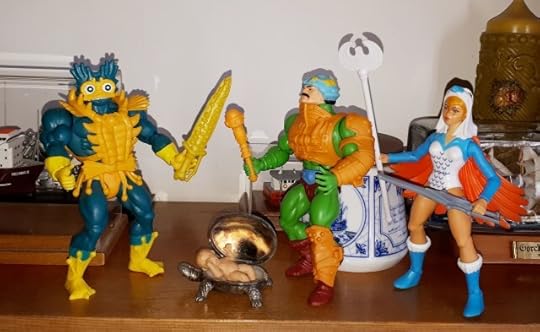
Yes, I know the Sorceress puts her baby in a bird’s nest in the original cartoon for reasons best known to herself. However, I did not have a bird’s nest, though I did have a turtle-shaped silver pill box. The baby is a figurine for baby showers and the like that just happens to have the right scale.
“Hah, this child will make a tasty morsel for our Lord Cthulhu, when he rises from the depths.”
“Over my dead body, fiend!”
“Duncan, protect our daughter!”
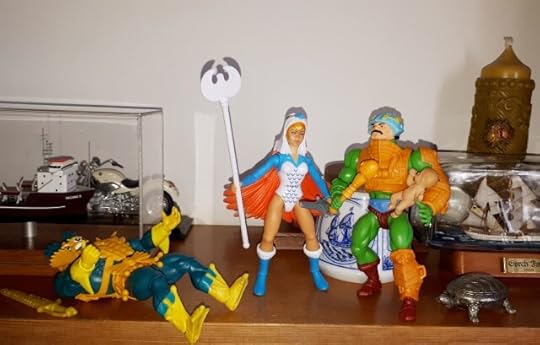 “You were right, Duncan. The royal palace is a safer place for our baby than a tortoise shell.”
“You were right, Duncan. The royal palace is a safer place for our baby than a tortoise shell.”
“Have no fear, my love. I shall protect our daughter – with my life if necessary.”
“Waahhh!”
“Don’t cry, little Teela. The big bad stinky Mer-Man can’t hurt you anymore. Here, Daddy has a rattle for you.”
“Duncan, that’s no rattle.”
“I know. But do you have a better idea to calm her down? Here, little one, look at the pretty flashing lights on the mace – err – rattle.”

Eternian Family portrait: The Sorceress, Duncan and Baby Teela.
But if the Sorceress is Teela’s mother, then who is her biological father? The original cartoon mentions an unnamed husband of the Sorceress, a brave warrior who died in battle.
Masters of the Universe: Revelation ditches the mysterious dead husband and simply shows us Duncan and the Sorceress as two people who fell in love and had a baby together. But then the Sorceress had to fulfill her mythic destiny and abandon all attachments and Duncan was left holding the baby.
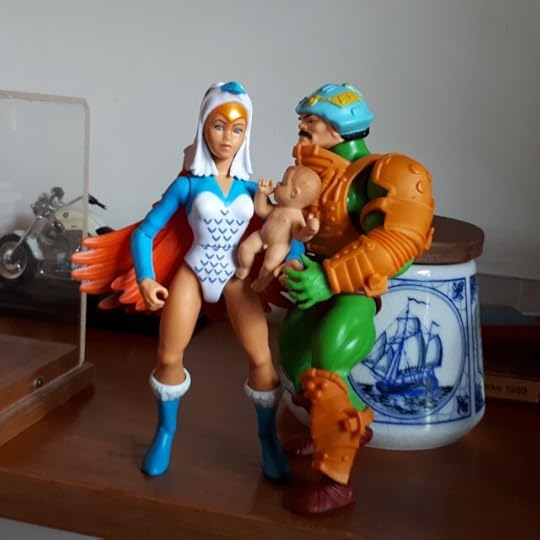
Eternian Family Portrait No. 2: The Sorceress and Duncan with their baby daughter.
I like this version of the story much better, if only because every version of this story from the original cartoon onwards has hinted that Duncan is in love with the Sorceress. It’s fairly low-key and I for one never noticed until very recently (probably because you don’t pay much attention to the parent figures, when you’re a kid, and certainly don’t want to imagine them getting romantically entangled), but it’s definitely there all the way back to the Filmation cartoons of the early 1980s.

Duncan and the Sorceress enjoy some quality time together in the bowels of Castle Grayskull.
The 2002 cartoon series, meanwhile, goes for a mix of both versions described above. Once again, Duncan is handed a swaddled baby by the Sorceress and once again, he vows to protect the child and raise her as his own. But unlike the Filmation cartoon from the 1980s, this version of the story gives us some more information about the Sorceress’ mysterious husband (who is very much not dead in the 2002 cartoon), though we still don’t learn his identity, largely because the Sorceress herself doesn’t know for sure.
Basically, the Sorceress gets bored being all alone inside Castle Grayskull all day and decides that she wants to see more of Eternia. Her magical powers don’t work very well outside the Castle, but well enough for her to defend a village against some attackers. All this happens during something called “the Great Unrest” (basically a civil war, which makes me wonder how the Sorceress thought this would be a good time to leave her magical castle empty and undefended). One day, a grieveously wounded soldier is brought into the village. The Sorceress nurses him back to health and they fall in love, even though the Sorceress has never seen his face, since it’s completely covered in bandages, nor does she know his name, because the soldier has amnesia due to his injuries. In fact, I suspect that main reason these two fell in love or rather lust with each other is because they literally are the only compatible humans in the whole village, which is inhabited by white little Ewok type creatures. At any rate, they get married. Apparently, either US children’s TV in general or Mattel in particular had a policy that characters have to be married before having children, even if that wedding is literally officiated by a small fuzzy Ewok critter. Eventually, the soldier recovers his memories and leaves the village and his pregnant wife behind, promptly forgetting all about her. And yes, I know that’s not how amnesia works and in fact this whole story sounds like the plot of a bad Mills & Boon/Harlequin romance novel with a title like The Wounded Soldier’s Secret Baby.
But who was that mysterious soldier? The episode in which the Sorceress recounts that tale heavily implies that it was Duncan himself, especially since Duncan and the wounded soldier have the same square jawline. However, the writers were apparently planning to go into a different direction and reveal that Teela’s biological father was none other than Fisto.
What the fuck…?
That was my reaction, at any rate. True, he may be partly inspired by late medieval knight Götz von Berlichingen, who had an iron hand prosthesis to replace a hand lost in battle, with a bit of Karl Edward Wagner’s Kane thrown in, but Fisto has always been a bit of a joke. He is the character who gave birth to a thousand memes and mainly seems to exist to allow the writers to sneak fisting jokes into a kids show. Even the Götz von Berlichingen connection is appropriate here, because nowadays, the historical Götz von Berlichingen is mainly remembered for the very rude quote that Johann Wolfgang von Goethe gave him in his eponymous play about Götz, much to the delight of every German schoolkid forced to read that play.
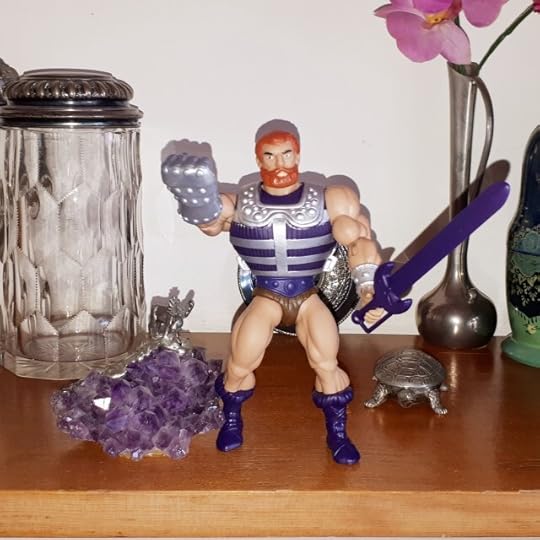
Could this man be Teela’s biological father?
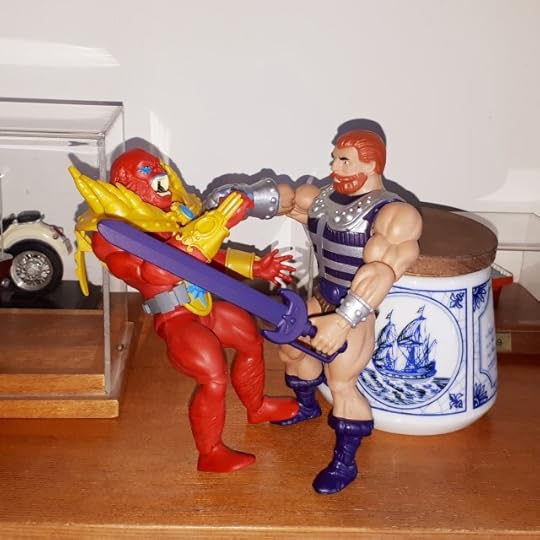
“Eat steel knuckles and tell Skeletor that he can lick my arse.”
The strict standards of US children’s TV with regard to swearing prevent Fisto from quoting the other steel-fisted warrior Götz von Berlichingen, but he has always been something of a weird character.
When he was first introduced in the Filmation cartoon in 1984, Fisto was actually a villain of sorts, a grumpy loner who lives in the forest and harrasses Eternian peasants until the superior fists of He-Man and the power of kindess make him see the error of his ways and join the good guys.

Fisto in his grumpy woodsman persona.
As an origin story, it’s weird and I now wonder whether Fisto was initially intended to be a villain, until Mattel decided to make him one of the good guys or whether Filmation just told the story they wanted to tell, toy continuity be damned. And because Fisto had such a weird origin story, the 2002 cartoon retconned it somewhat. In this version, Fisto is still a grumpy loner who hangs out in seedy bars and gets into fights. However, this Fisto is also the estranged brother of Man-at-Arms. Duncan and Fisto a.k.a. Malcolm don’t get along with each other – which is unusal, because Duncan gets along with everybody – and nearly come to blows more than once, though Fisto also saves everybody’s lives and badly damages his hand in the process, which is why Duncan builds the iron fist for him. The reason why Duncan and Fisto don’t get along is that Duncan thinks Fisto is a coward and deserter, because he vanished in the middle of a battle. Fisto, however, insists that he was injured and had amnesia… just like the Sorceress’ wounded soldier.
Fisto only shows up in the last few episodes of the 2002 cartoon and so the mystery of who Teela’s father is remains unsolved on screen, though someone from Mattel later confirmed that Fisto was supposed to be revealed as Teela’s biological father eventually. However, personally I prefer Duncan to be both the biological father and the parent who actually raised Teela. For starters, because both Teela and the Sorceress deserve better than Fisto. Never mind that I have a hard time believing that a guy called Fisto is straight.
Still, since I had all the required figures, I made a little photo story about what happens when Duncan confronts Fisto about this:
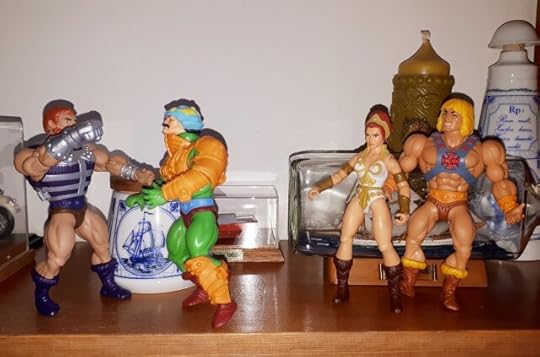 “Get out of my sight, Malcolm. You’re a coward and deserter.”
“Get out of my sight, Malcolm. You’re a coward and deserter.”
“I was wounded and had amnesia.”
“Right, and isn’t that a convenient excuse?”
“So you’re calling me a liar?”
“He-Man, do you think we should intervene?”
“No, Teela, they need to sort this out between themselves.”
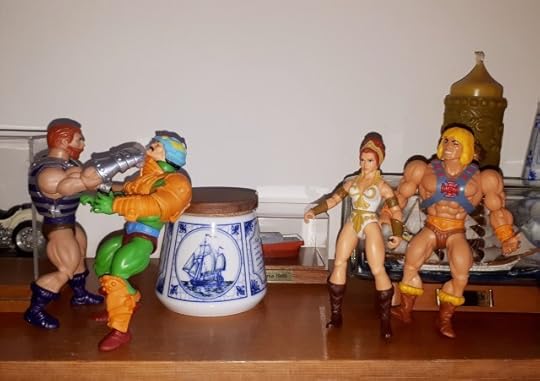 “You’re a coward, a deserter and you slept with my girlfriend, arsehole!”
“You’re a coward, a deserter and you slept with my girlfriend, arsehole!”
“What?! I’m pretty sure I’d remember that.”
“So you’re denying you slept with my girlfriend?”
“Duncan, you never even had a girlfriend. Always way too focusses on your duty to have a bit of fun.”
“At least I did my duty. Unlike you, deserter.”
“Eat steel knuckles, shithead!”
“That’s it. I’m stepping in.”
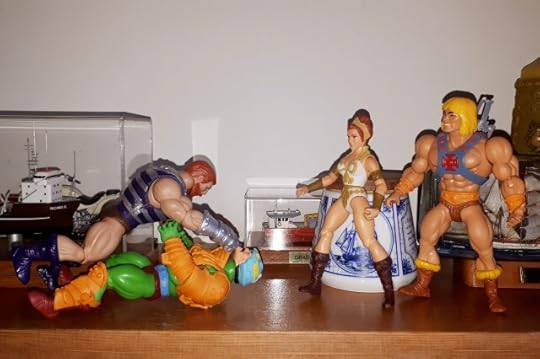 “I agree, Teela. Let’s stop them before they hurt each other.”
“I agree, Teela. Let’s stop them before they hurt each other.”
“Had enough yet, Duncan? Or do you want some more of my iron fist?”
“Anytime, deserter and girlfriend poacher.”
“Father, Uncle, stop it!”
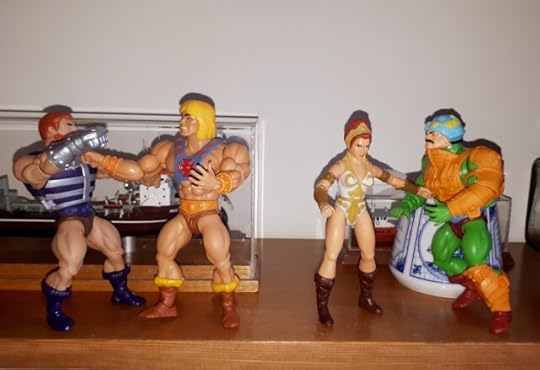 “No, Dad, he’s not worth it. Save it for Skeletor.”
“No, Dad, he’s not worth it. Save it for Skeletor.”
“What’s the matter, Duncan? Hiding behind your daughter? So who’s the coward now?”
“That’s enough, Fisto. Stand down or you’ll feel my fist.”
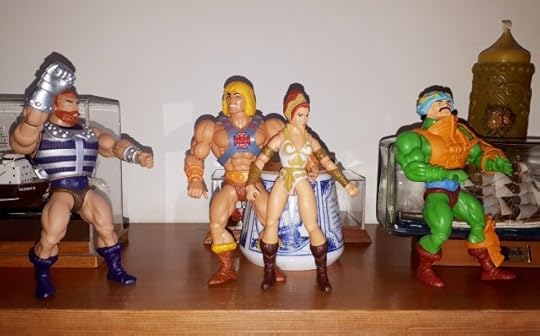 “That’s it. I’m talking to the other person who knows the truth. And she will tell me.”
“That’s it. I’m talking to the other person who knows the truth. And she will tell me.”
“Father, come back!”
“Yeah, run off, Duncan, like the coward that you are.”
“Shut up, Fisto!”
“So, He-Man. do you have any idea what that was all about?”
“Uhm, Teela, you’d better ask your father about that.”
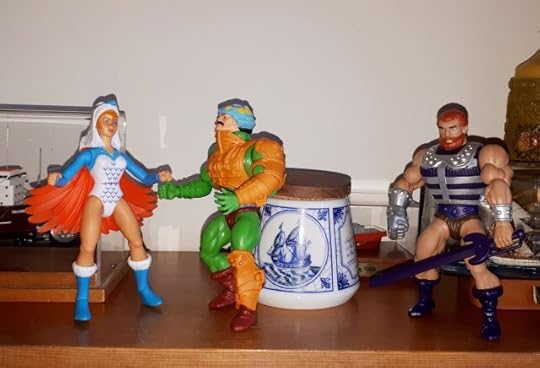
A bit later, at Castle Grayskull…
“No, Duncan, I did not sleep with your loser brother. What do you take me for?”
“He’s not a loser. Okay, he is, but… are you sure, my love? Cause he said…”
“Of course, I’m sure. I do remember who I sleep with.”
“My love, wait. I’m sorry. I…”
“Uhm, Duncan, if it helps, I’m actually gay and she’s so not my type.”
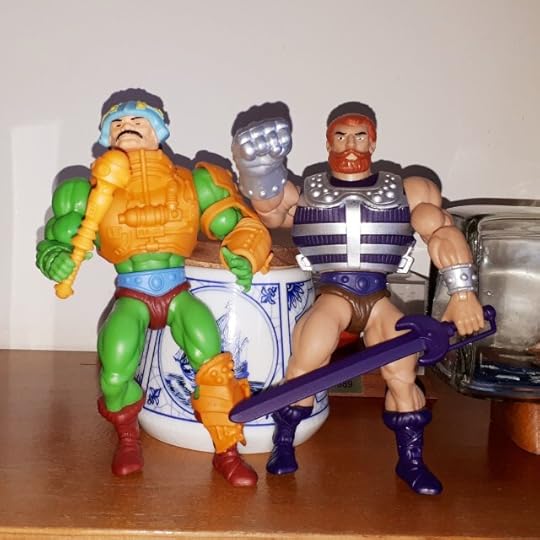
Brothers in arms: Man-at-Arms and Fisto a.k.a. Duncan and Malcom
“Wait a minute, you’re gay? Why did you never tell me?”
“Because you’re… well, you’re you. You’re straight as an arrow and you always find fault in me, so I had no idea how you would react.”
“How do you think I would ract? You’re my brother and I love you.”
“Only that you forget that at times. But anyway, you and the Sorceress…?!”
“Got any problems with that?”
“No, I’m just surprised, that’s all. And Teela…?”
“Is our daughter, but don’t you dare tell her. So, Malcolm, do you… uhm … have anyone?”
“Yeah, but that’s private. So about the Sorceress, I’m curious. Are those wings part of her outfit or her body?”
“That’s private. But maybe I’ll tell you over a drink.”
“Yeah, let’s have a drink.”
I actually wanted to take a picture of Duncan and Fisto sharing a drink, but it turns out that I did not have any bottles or beer glasses in a remotely correct scale. The only thing I had was a Playmobil baby bottle, which isn’t really suitable. And even though I have decided that Fisto is gay in my head canon, I have no idea whom I’ll eventually fix him up with.
Anyway, the secret identity of He-Man and the origin of Teela are the two long-standing secrets that are revealed in Masters of the Universe Revelation. However, there are yet more dark secrets surrounding the royal family of Eternia.
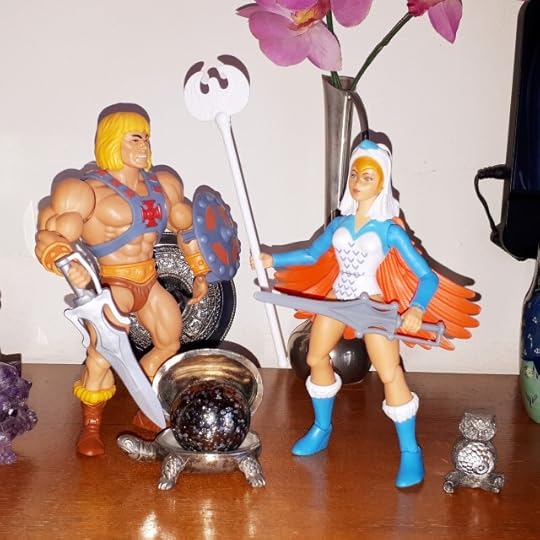
The Orb of Power is actually a shiny marble, but it works really well.
“And this, He-Man, is the Orb of Power, from which all the power in the universe flows into your sword.”
“Why is it sitting in a tortoise shell?”
“Because the tortoise shell was useless as a baby crib, but makes a good orb holder.”
“What do you need a baby crib for?”
“Ahem, that’s private. Anyway, the Orb…”
“Wait a minute, why does your sword look like the twin of mine?”
“Not all secrets shall be revealed today, He-Man. Anyway, the Orb…”
So tune in again for the next installment of my Secrets of Eternia Photo Stories, where we tackle the mystery of He-Man’s long lost sister…
Disclaimer: I don’t own any of these characters, I just bought some toys, took photos of them and wrote little scenes to go with those photos. All characters are copyright and trademark their respective owners.
Cora Buhlert's Blog
- Cora Buhlert's profile
- 14 followers


